
Over the weekend, while we were in Lille, we took a tour of the Winckelmans tile factory. The tour was actually the primary reason for our visit to Lille. We’re using Winckelmans tile for the bathrooms in our renovation — I’ve never ordered custom tiles before and wanted to see what the process was like.
And honestly I was blown away. The materials, the handwork, the science, the quality, the history. The whole thing is such an art and a skill. And getting to see the bags of colored sand turned into basically indestructible tile right before our eyes was such a cool thing.
I’m going to take you through our tour and tell you everything I remember. I took a ton of photos, so it will be a visual tour too.
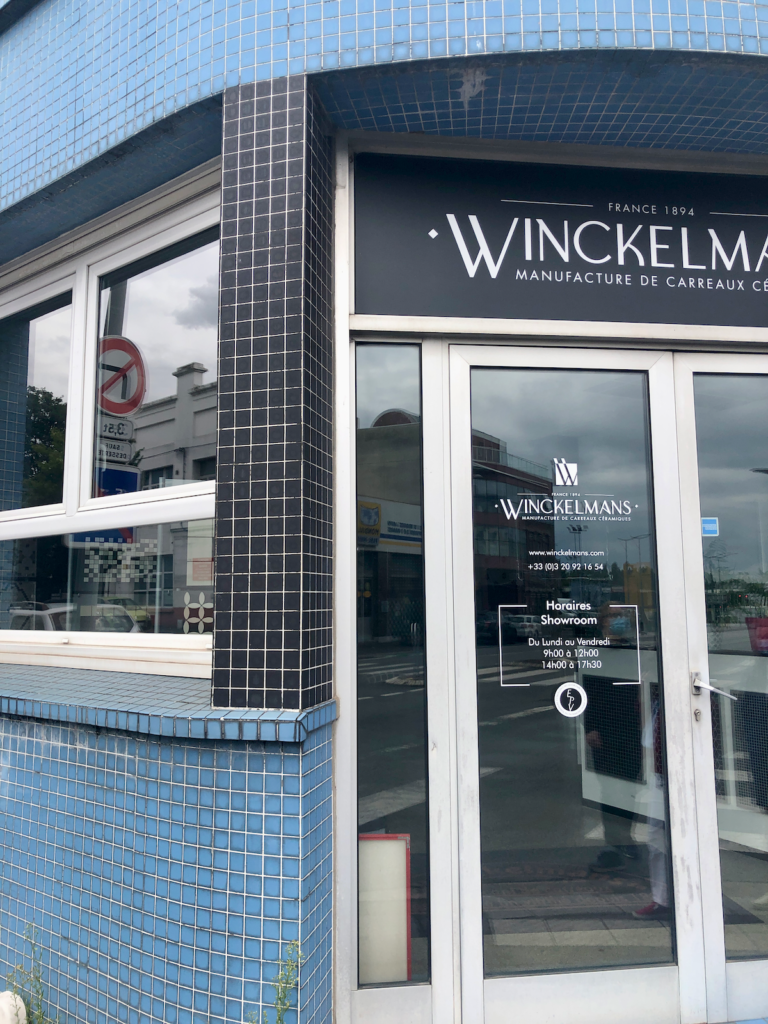



First, we gathered in this conference room to learn a little bit about the history of Winckelmans. It doesn’t sound like a very French name, right? The original founder was actually Dutch, but founded the company in Lille in 1894. It’s still run by the same Winckelmans family — now five generations later!
It’s currently run by Barbara Winckelmans. Her great-great grandfather was the original Winckelmans. Then his son ran it. Then his son. Then his son. And then his daughter, Barbara. This was unexpected. Barbara had an established career as a nurse, but her father got sick, and knew he was going to die, and asked Barbara to take over the family business. So she did. And she’s improved the company in incredible ways.

A few key things I remember about the history of Winckelmans:
-Early in the 1900s, there were quite a few tile factories in France, and they all made basically the same thing: matte ceramic tiles with straight edges in small shapes, no gloss. As things started to modernize, these factories essentially all converted to new trends — much bigger tiles, with high gloss finishes.
But Winckelmans resisted. They made the conscious decision not to follow the new trends. They decided they would continue to only make small matte tiles. And they are the only factory in France who still does!

-During WWII, the British actually bombed Winckelmans by accident. The factory has train tracks (see below) that used to bring in the raw materials, and the British military thought the train tracks were a train station (one of their targets).

Almost the entire factory was destroyed. But, one kiln survived, and one of the original three chimneys survived.
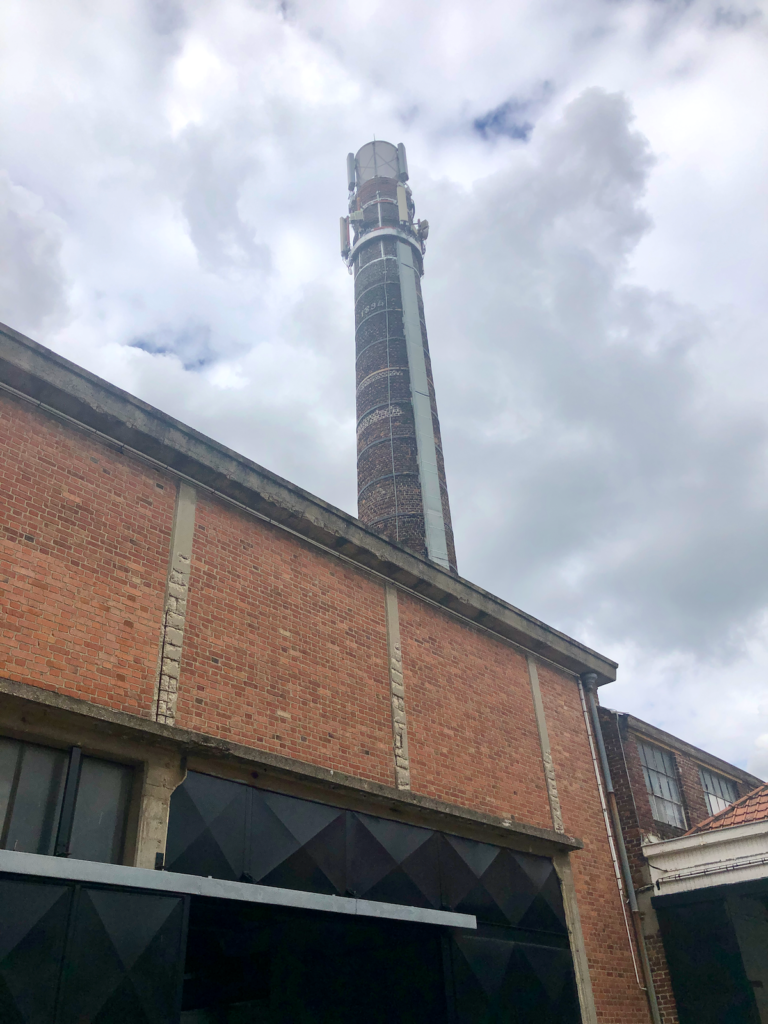
Some of the original panels of tile near the entrance also survived. They are so cool:

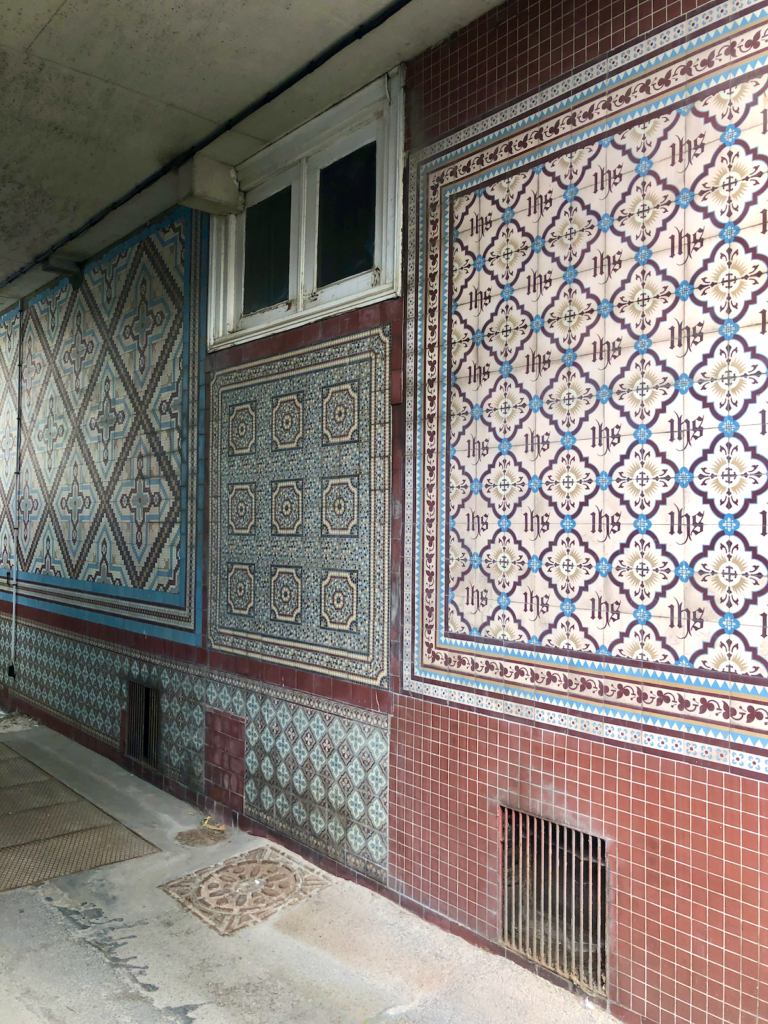
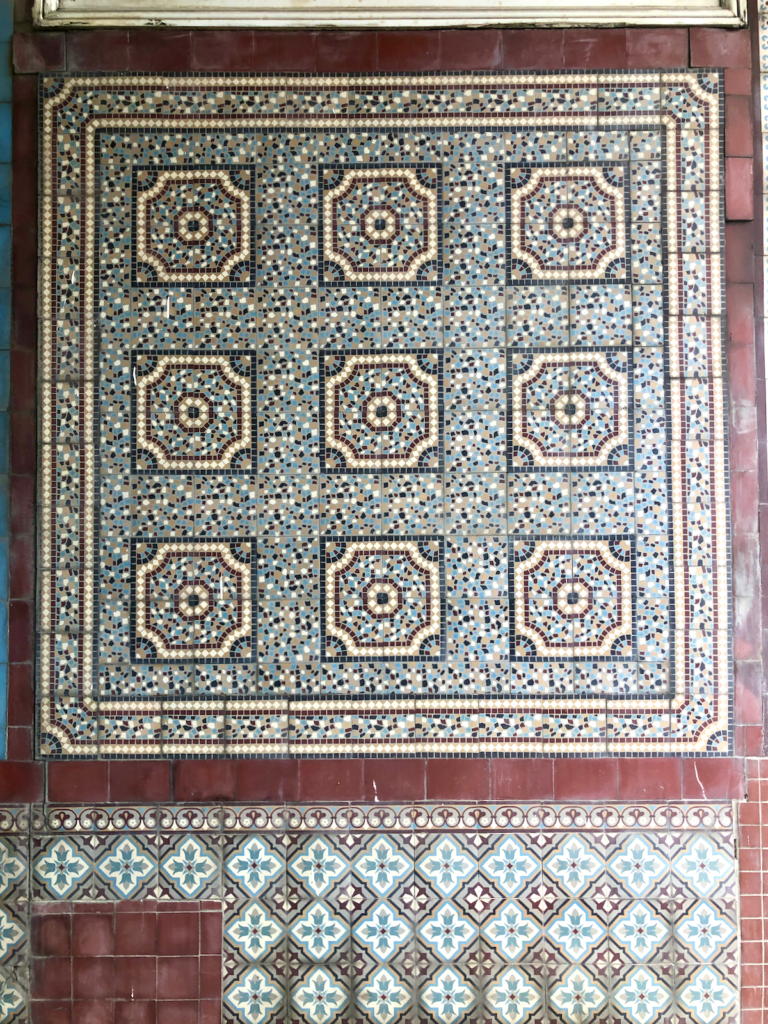
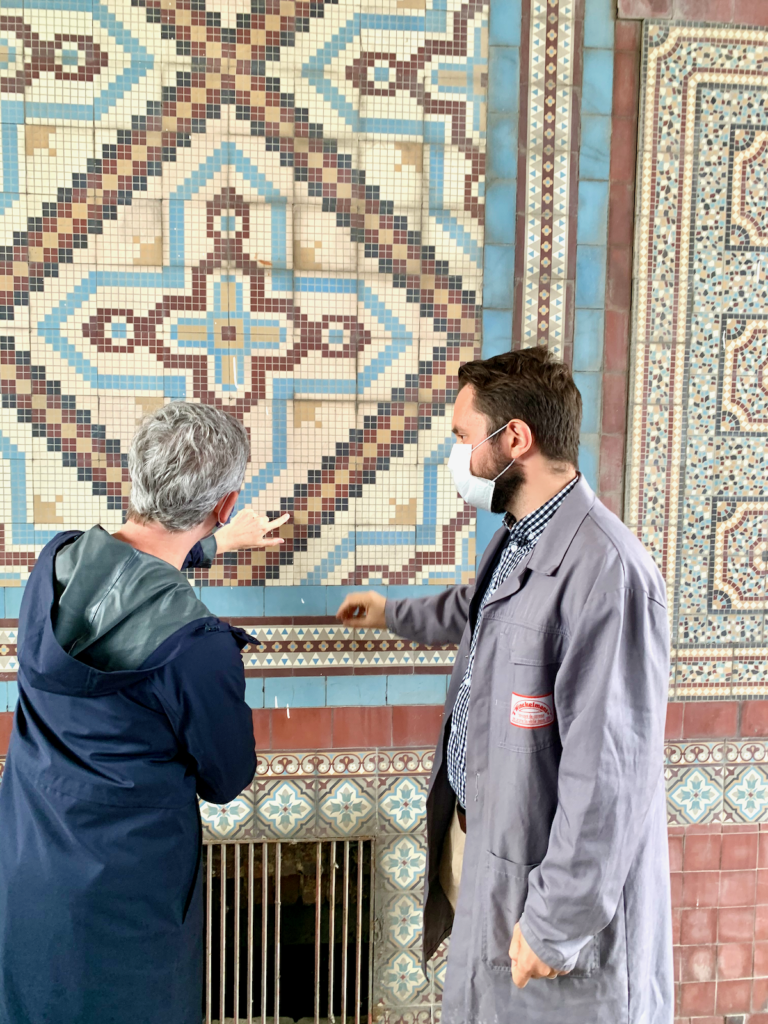
Since the war, the entire factory has been rebuilt:

-Winckelmans supplies tile all over the world, including the U.S., for new projects and for restoration projects. If you have small matte, straight-edge tiles in your building, home, restaurant, or school, or have ordered tiles for restoration, it’s pretty much guaranteed they came from Winckelmans.
Though some of the processes have modernized, the tiles are made in the same way and in the same colors as they have been for over a century. It’s amazing.

-Winckelmans creates tile for hi-end French fashion brands. One brand has a particular favorite pattern of small square tiles, and they change the color of the pattern for each individual store.
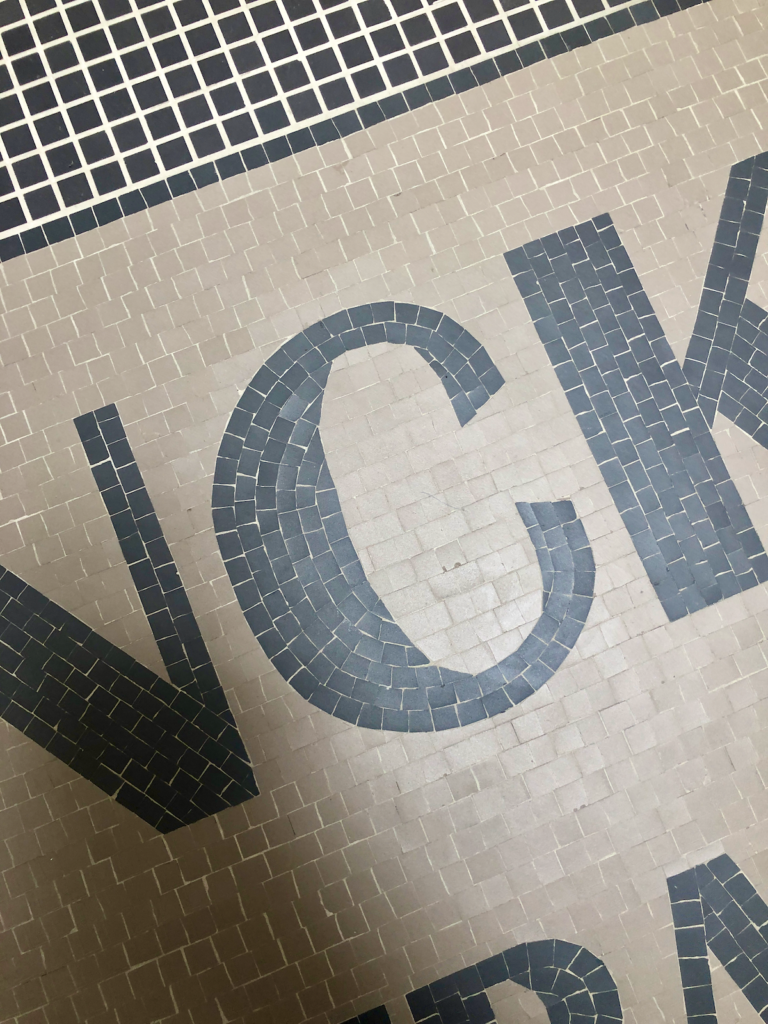
And if you’ve ever seen a floor logo in Paris set in cut tile, it was probably made by Winckelmans. It takes around 5 weeks to build one of these cut-tile logos! Each tiny piece is cut by hand. Someday, I want to have a cut-tile installation that says “Famille Blair depuis 1995” for the entry of our house — like a fancy hotel!
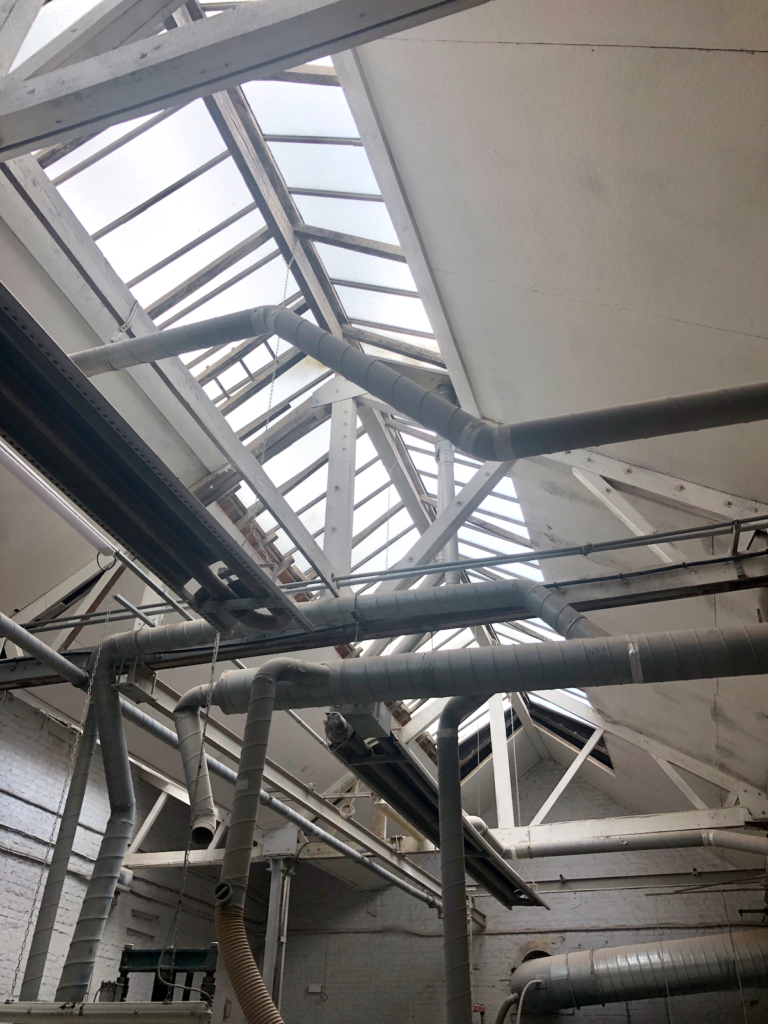
-When Barbara took over Winckelmans, much of her first projects were based on the workers’ quality of life. She added natural light to all the factory spaces. She brought in insulation panels to absorb sound from the big machines to protect workers’ hearing. She invested in huge filters that keep the air clean and breathable in the factory buildings.

Wherever possible, she converted the processes so that machines were doing the physical (heavy!) lifting of tile instead of humans, to prevent back injuries. She modernized the whole thing, making the work safer and healthier, without changing the integrity of the process or product. (I love woman leaders!)
-The tiles are completely made from natural materials, and in every tile they make, the colors go all way the through. Nothing is “printed” on. They start with raw materials and compress those materials into tile molds, which are then baked.
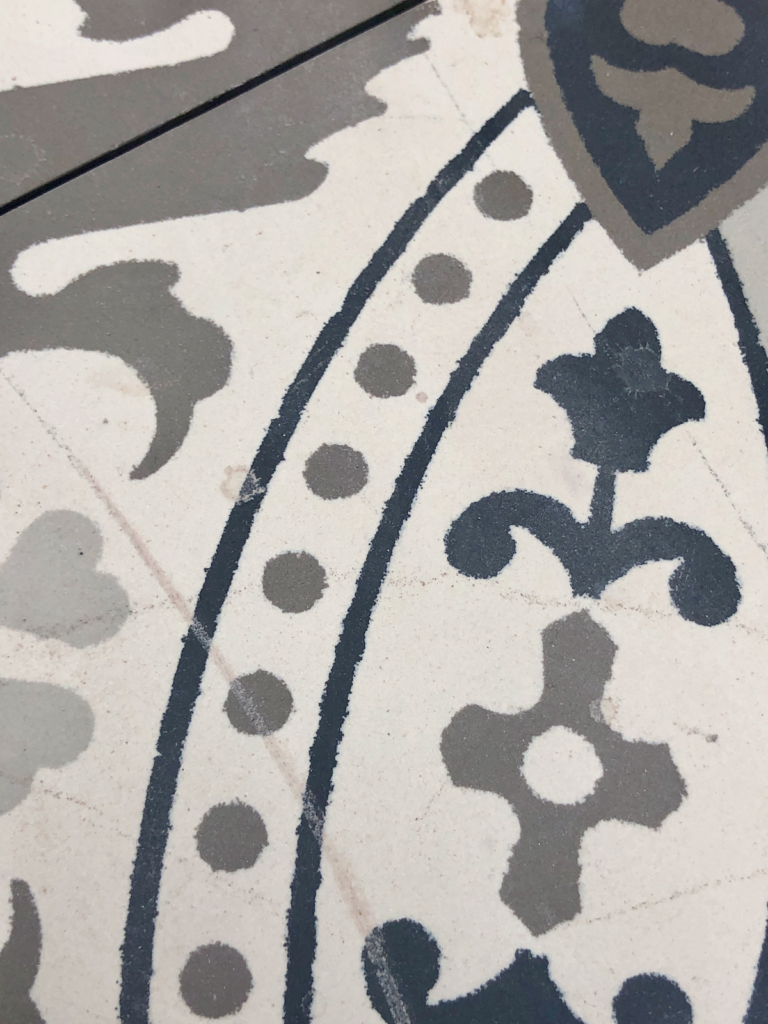
Even on the complicated designs it’s the same thing. It’s all compressed natural materials that are baked into a super hard surface. See the closeup of the tile above? Notice that edges of the design are not precise? That’s because the design is built from sand and it goes all the way through!
Side note: Speaking of the tile above, you may know that cement tiles are a huge trend at the moment. (And no wonder, they are so charming!) But cement tiles will degrade with moisture and are not safe for exteriors or for shower floors. Plus, they are inconsistently made so it’s hard to install them straight. If you’ve ever worked with them, you know they can be very frustrating. But these Winckelmans tiles — even the ones that looks like cement tiles — are completely water proof, incredibly strong, and super consistent. They are a dream to work with.

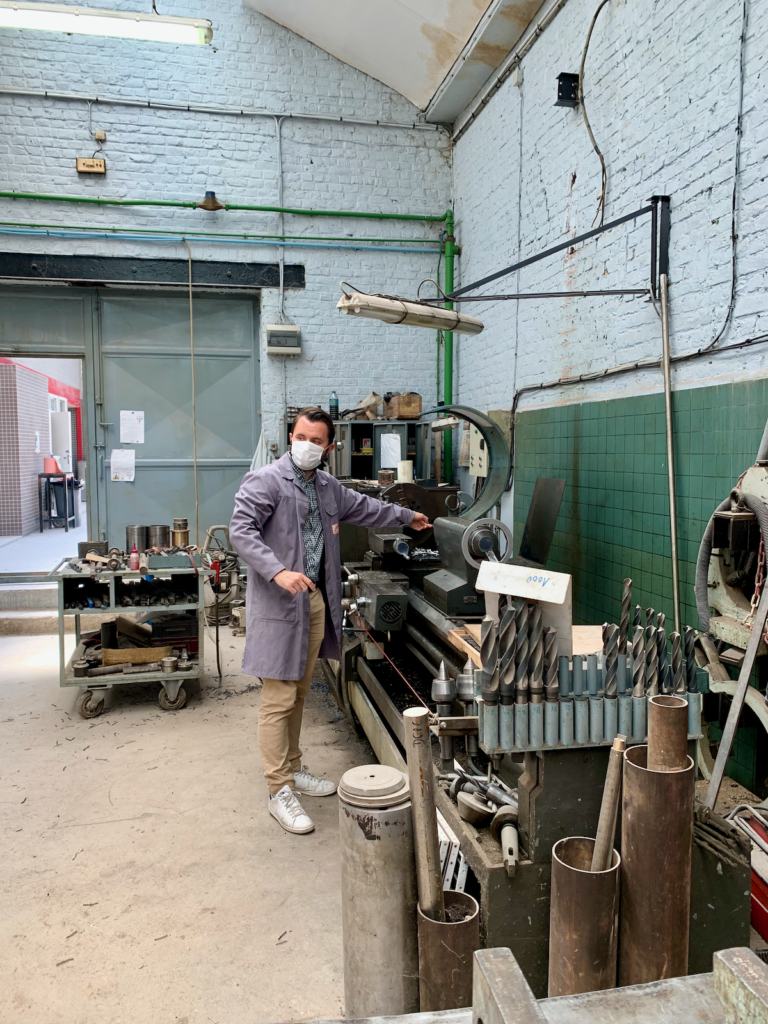
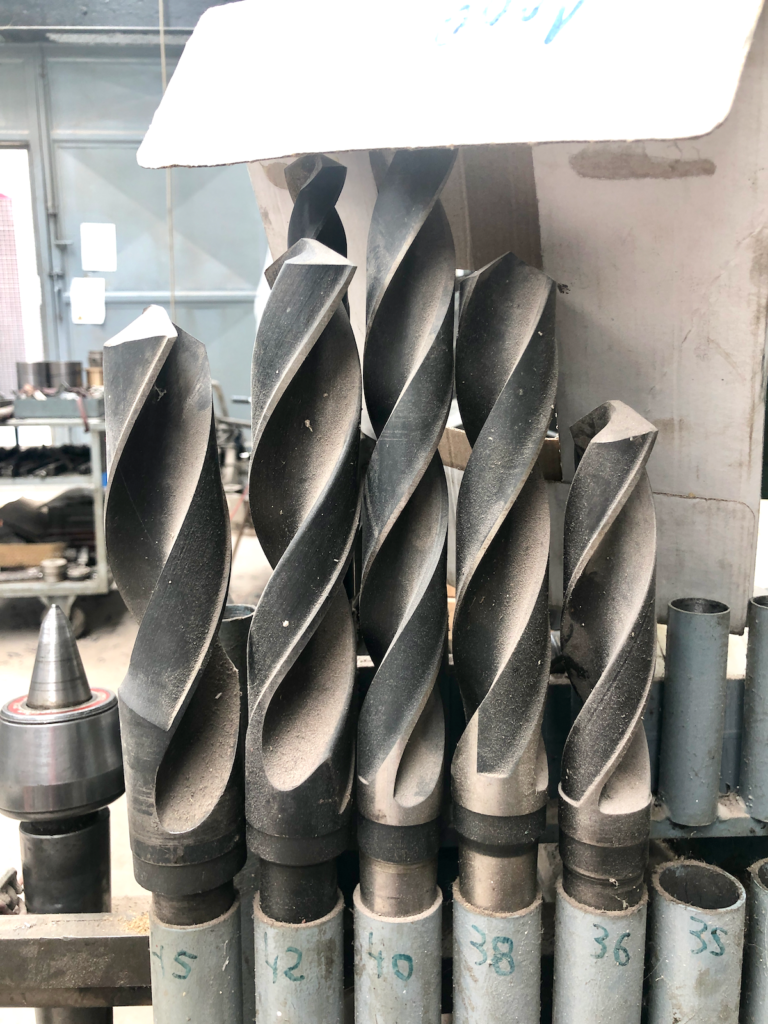
-Within the factory, there’s a workshop that’s just for maintaining the factory. They build every factory door, every machine part that’s needed. They can replicate tiny parts that are no longer available, and custom create solutions just for the factory. They also maintain and repair all the existing machinery.

After the history briefing we started the factory tour. We began where the tiles begin — with giant bags of raw materials. The bags are filled with special mixes of sand in different colors. (The materials for the sand are combined at another Winckelmans factory a couple of hours away.)
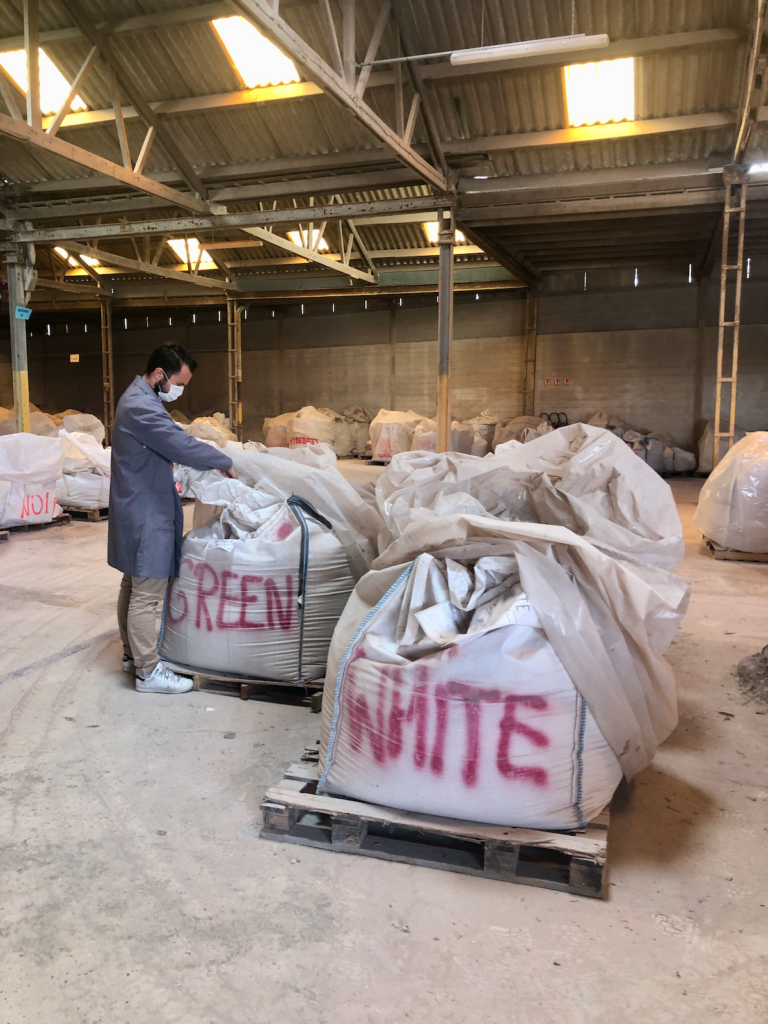
The materials for the sand are all natural and made from things like cobalt and red clay.
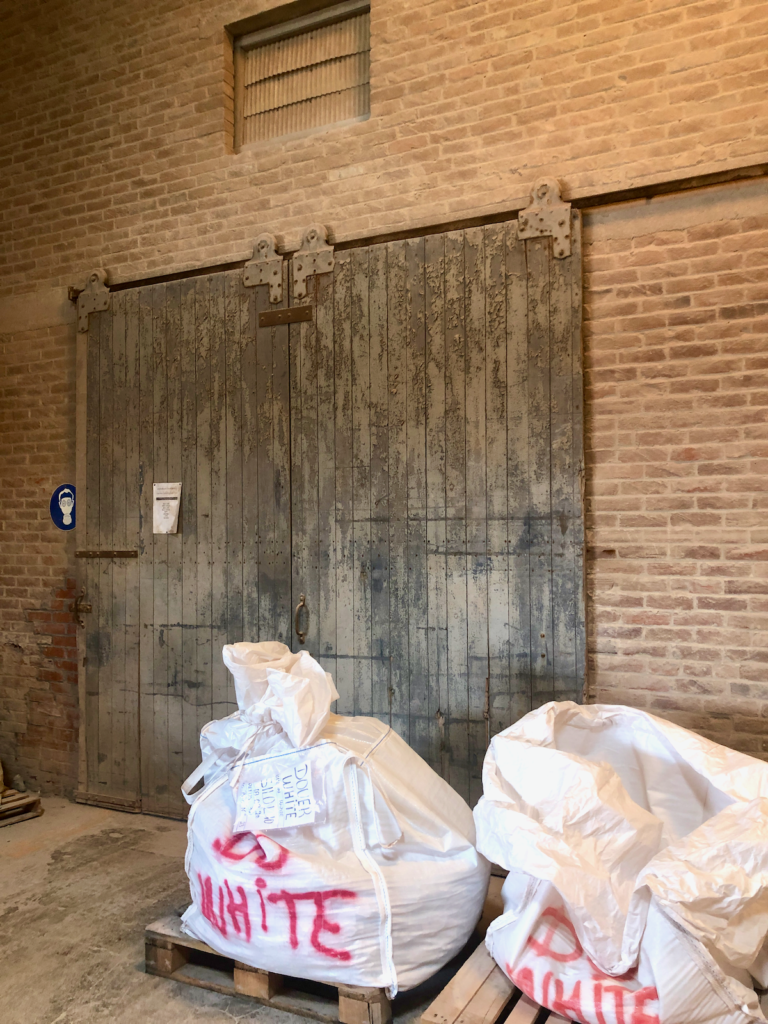
There are three different grain sizes of the sand. For solid colors, it’s a medium size grain.
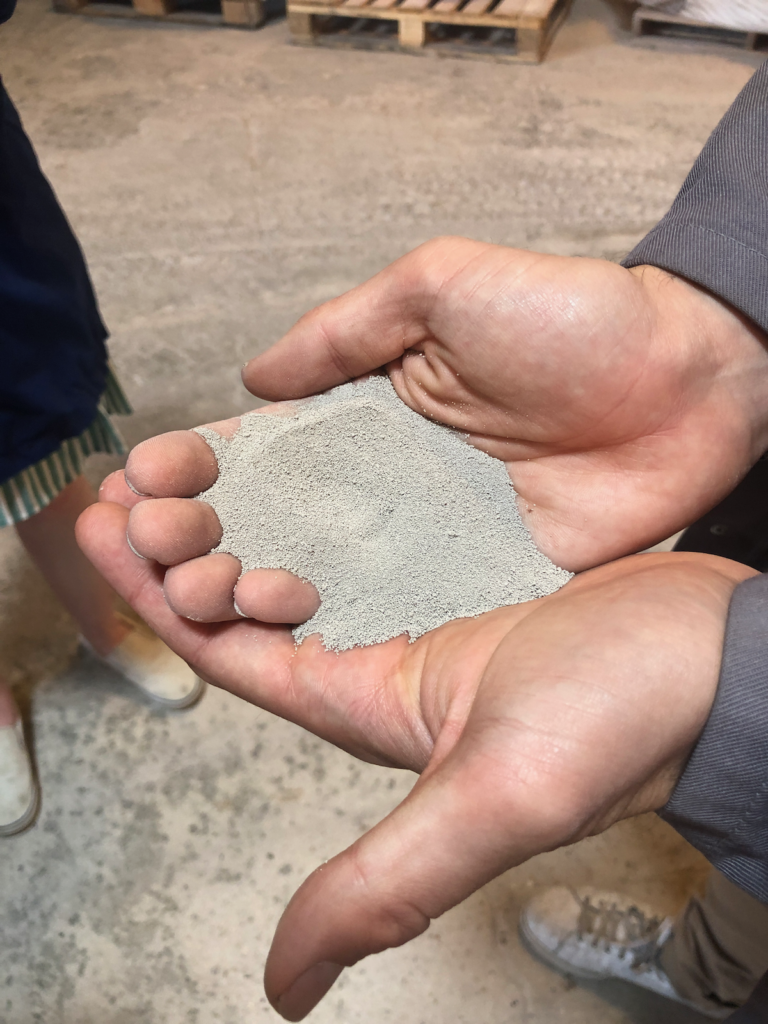
For speckled tiles, it’s a combination of course grains, and powdered grains.
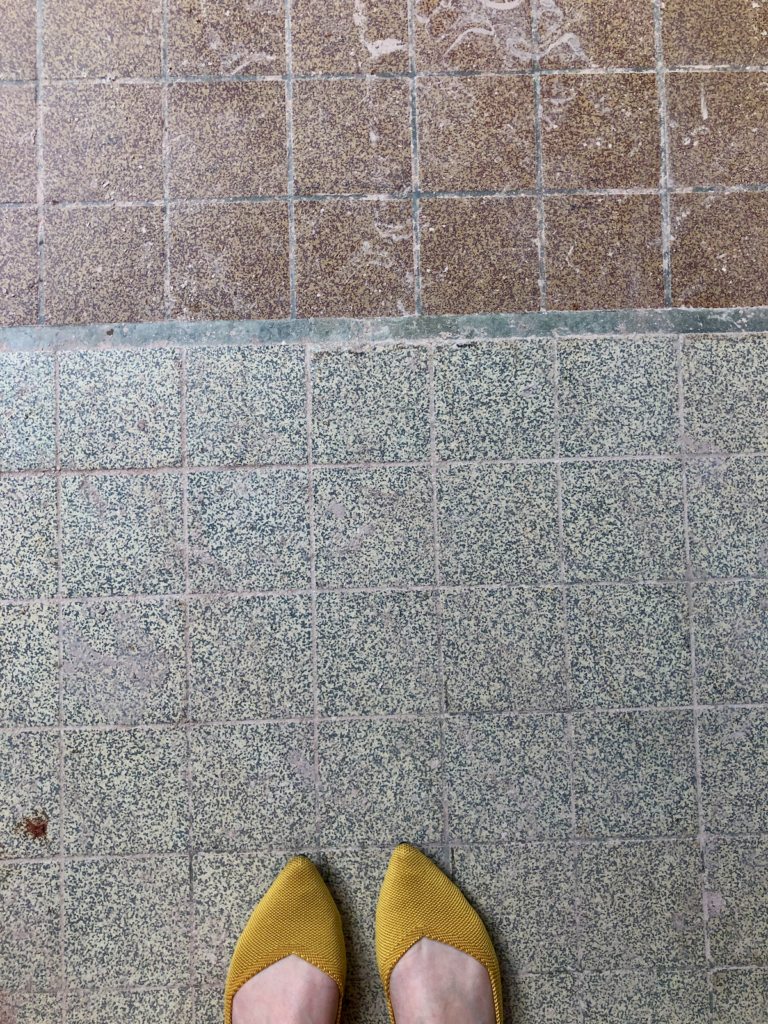
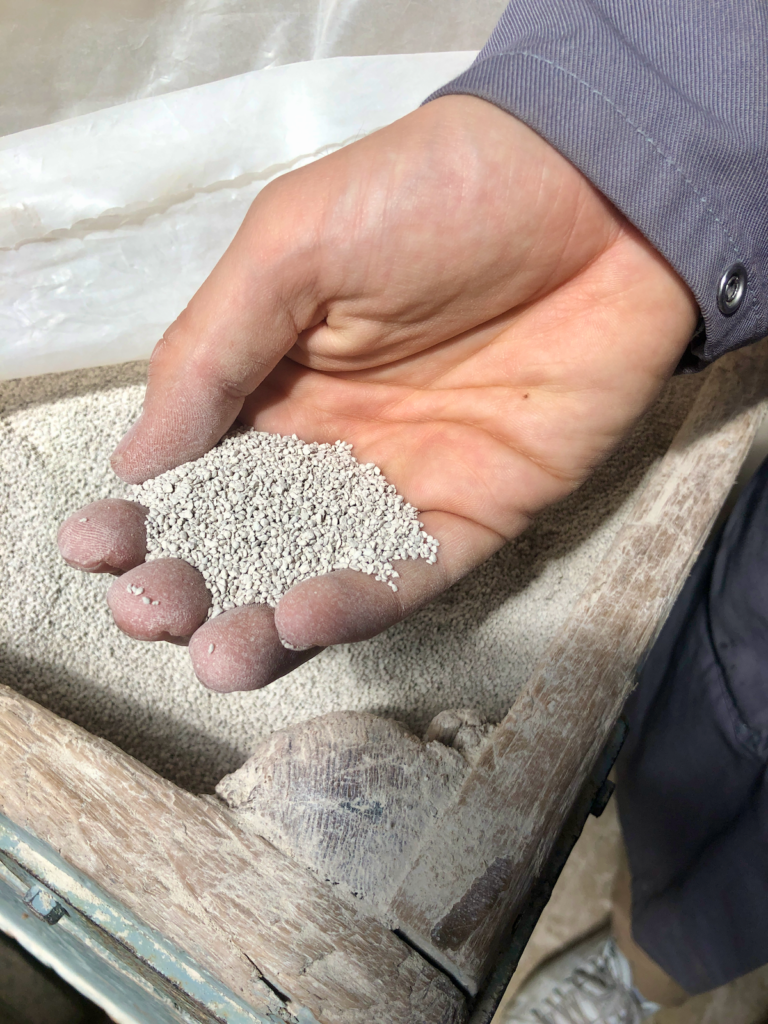
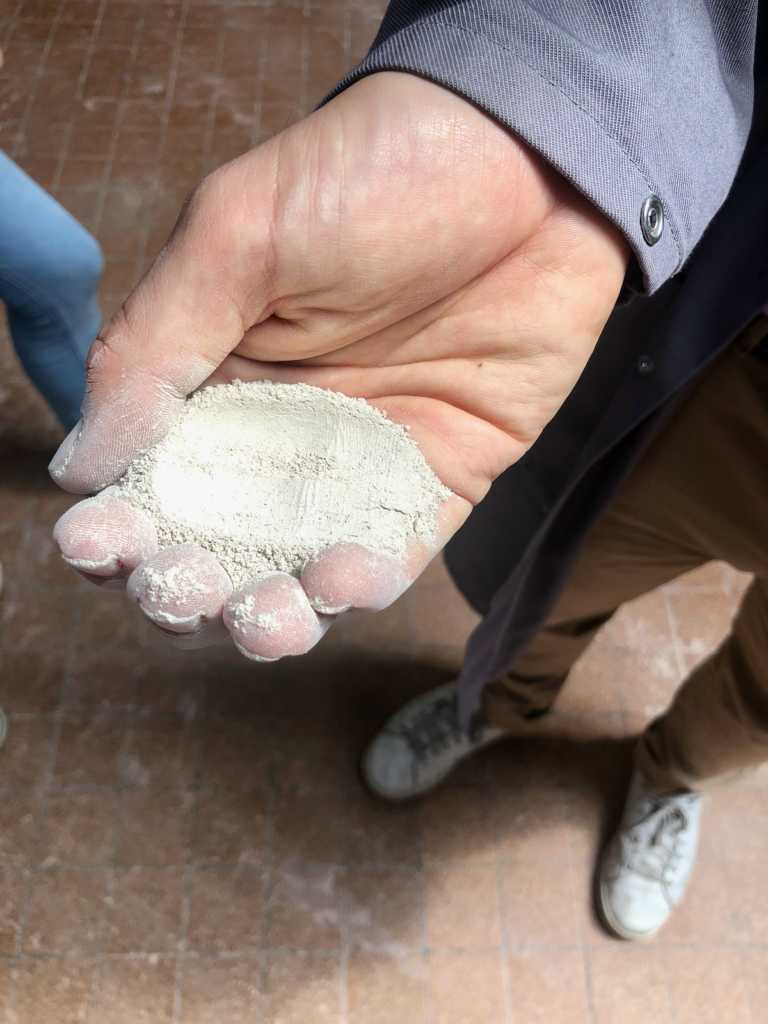
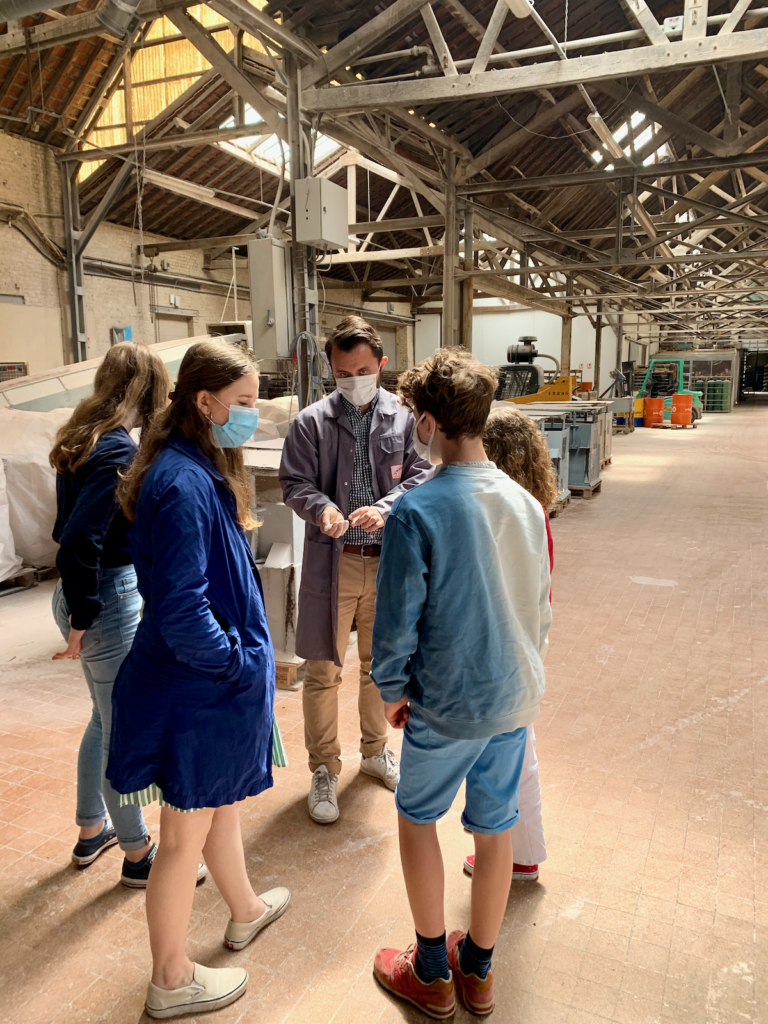
The sand is hauled around the factory in these rolling carts. (They are so charming! I think someone needs to make a replication of these and sell them as laundry carts.)

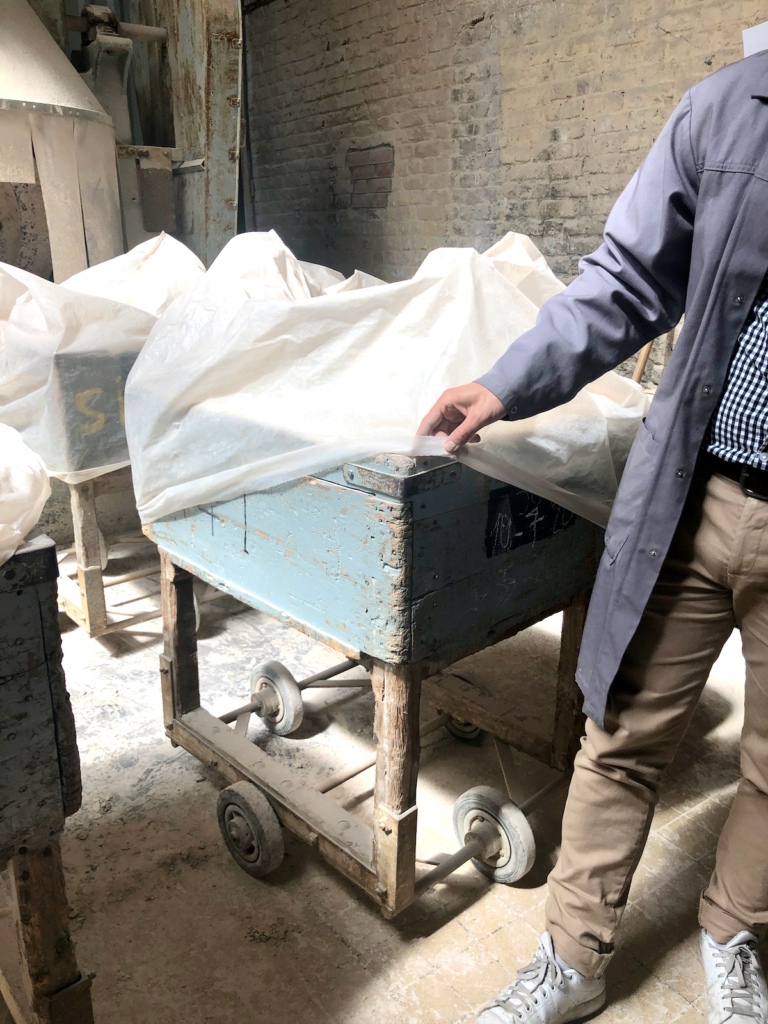
The sand is put through a machine that compresses it into these blocks:
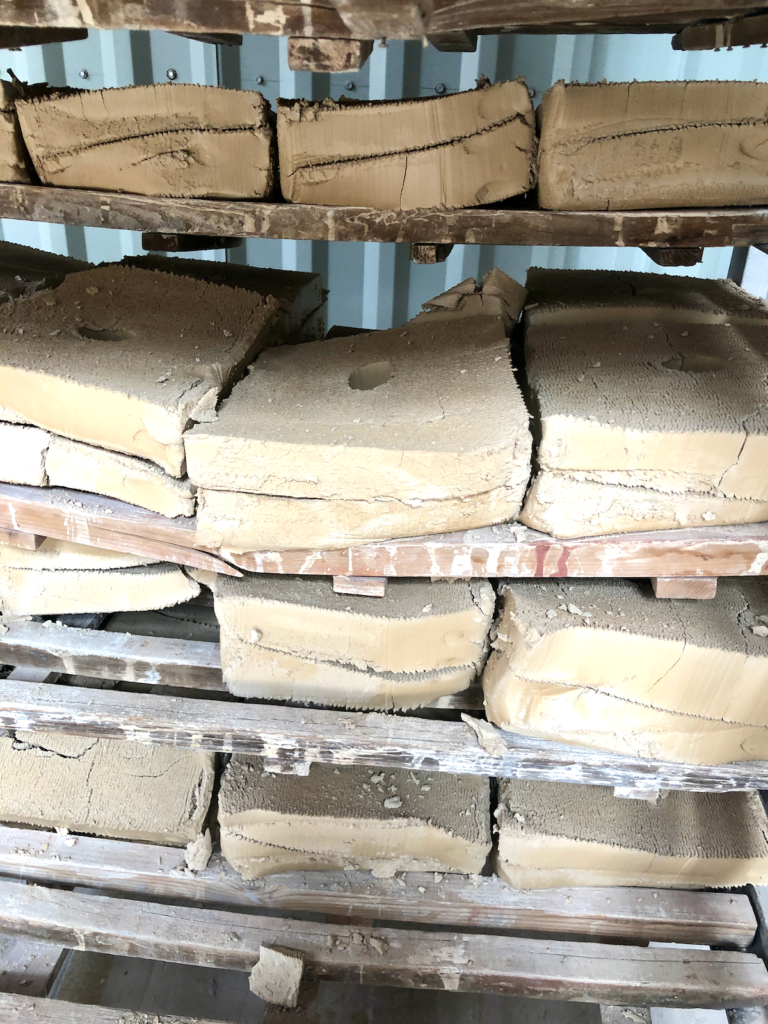
Then they are ready to be placed into molds.
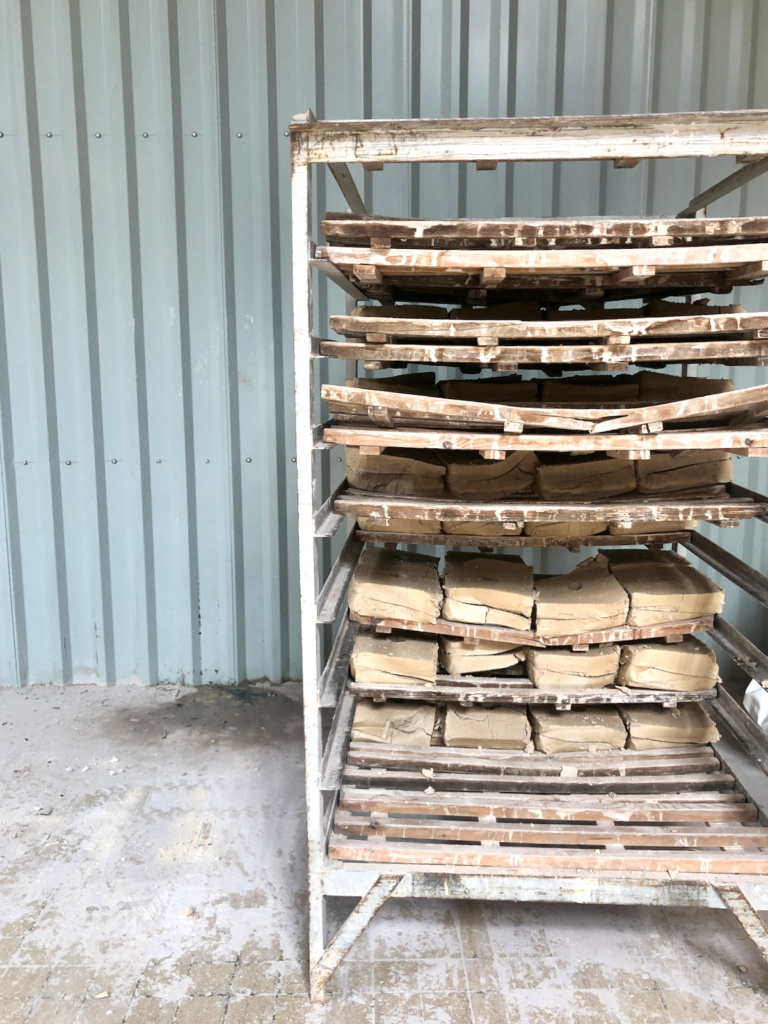

For the solid color tiles, the molds look like this:

Squares, triangles, hexagons, circles. Most shapes are very tiny.
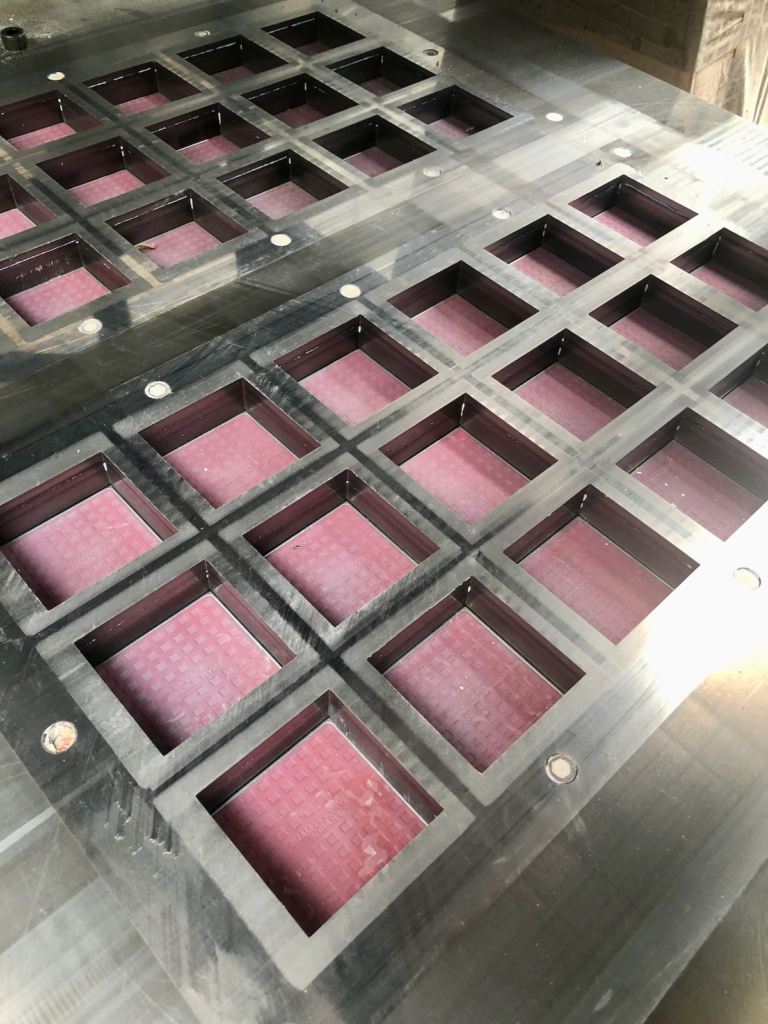
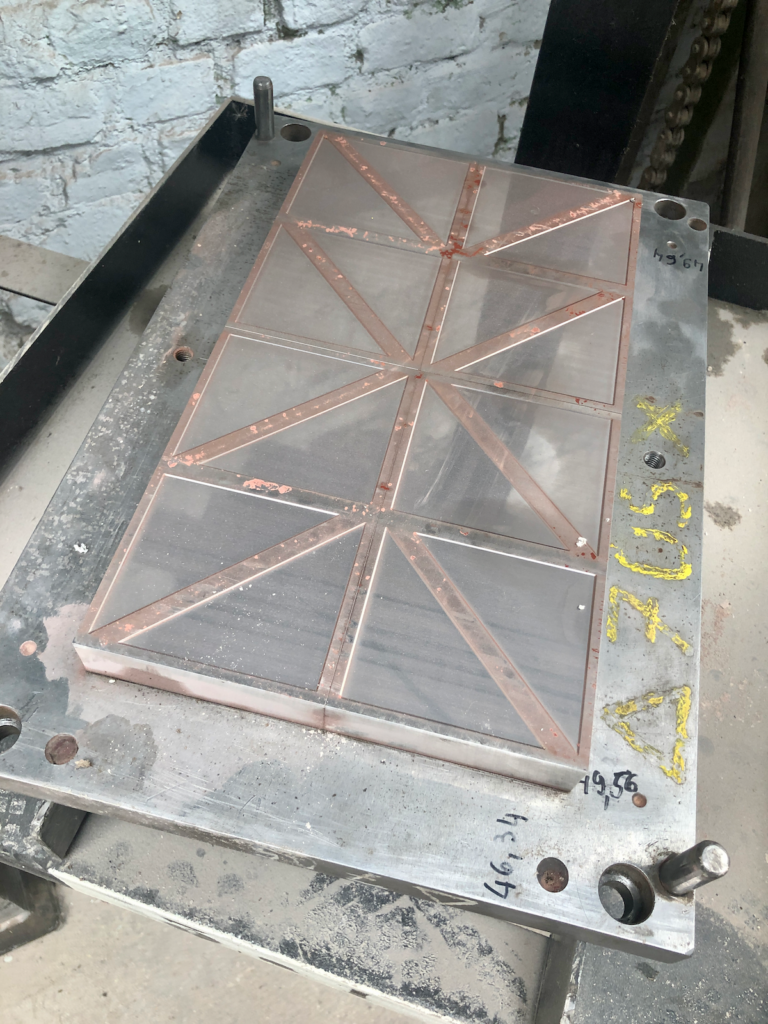
The molds are crazy expensive to make (about 30,000 euros!) and can last for 30+ years if they’re well taken care of. Here is the library of molds:

For tiles with a design (not solid colors), there are a couple of different options. There’s a machine that will carve out a block of steel with a design or pattern:
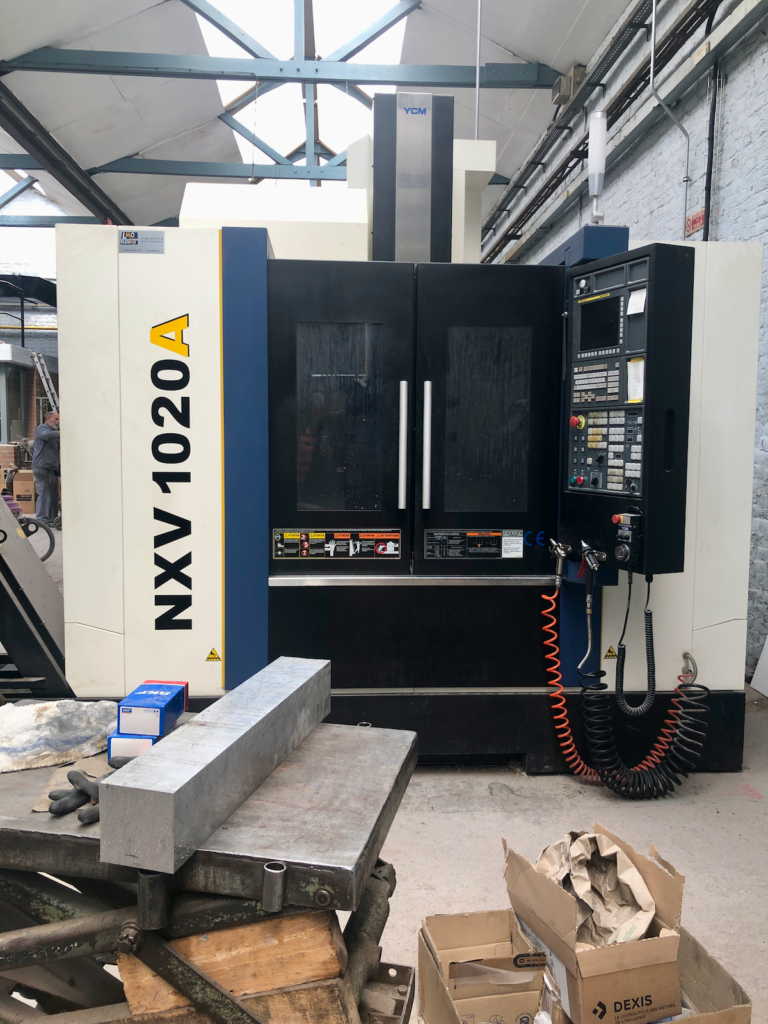

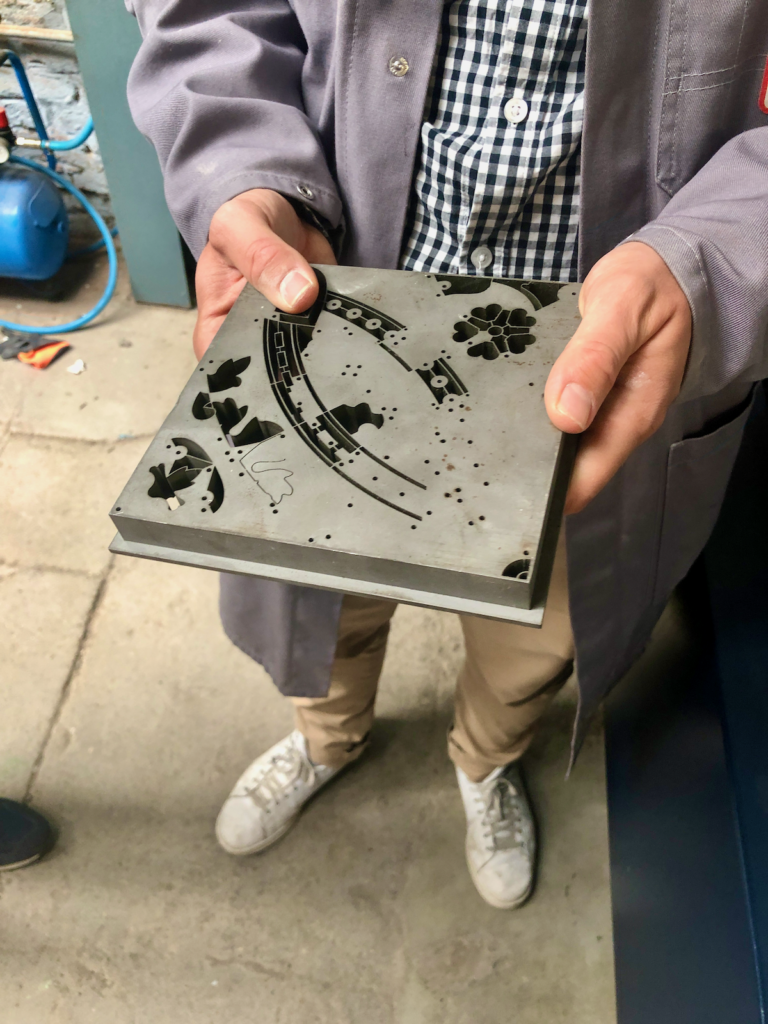
And there are also 3D printers that can create a custom mold. The 3D printed molds don’t last as long, but are much less expensive to create.
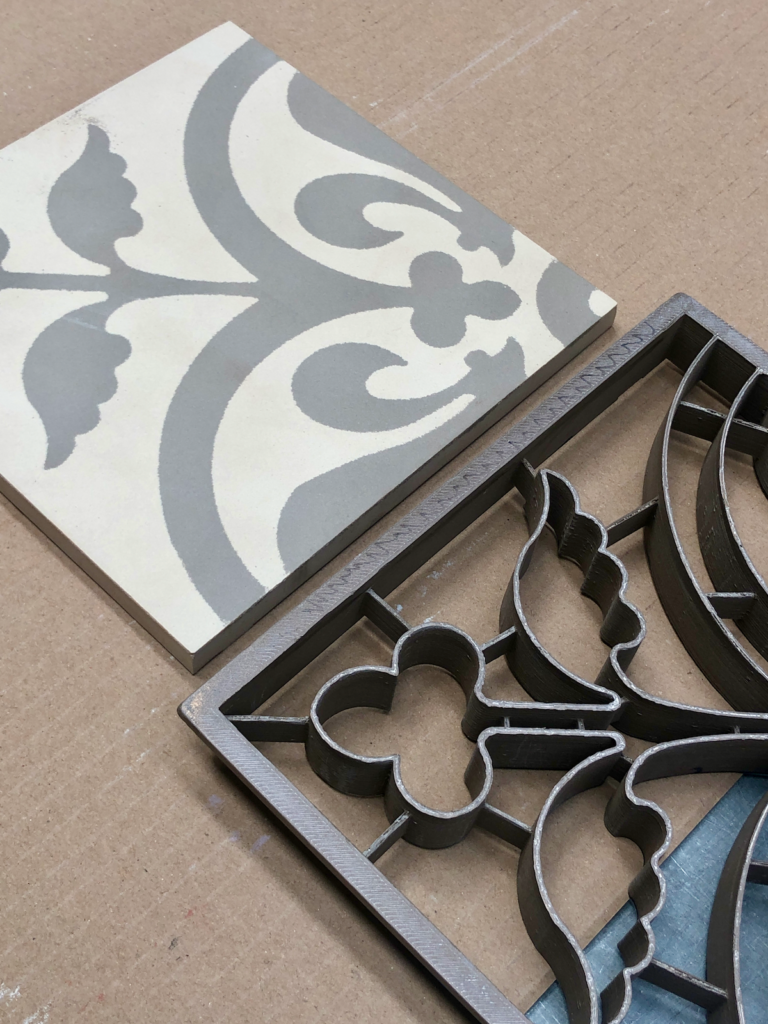
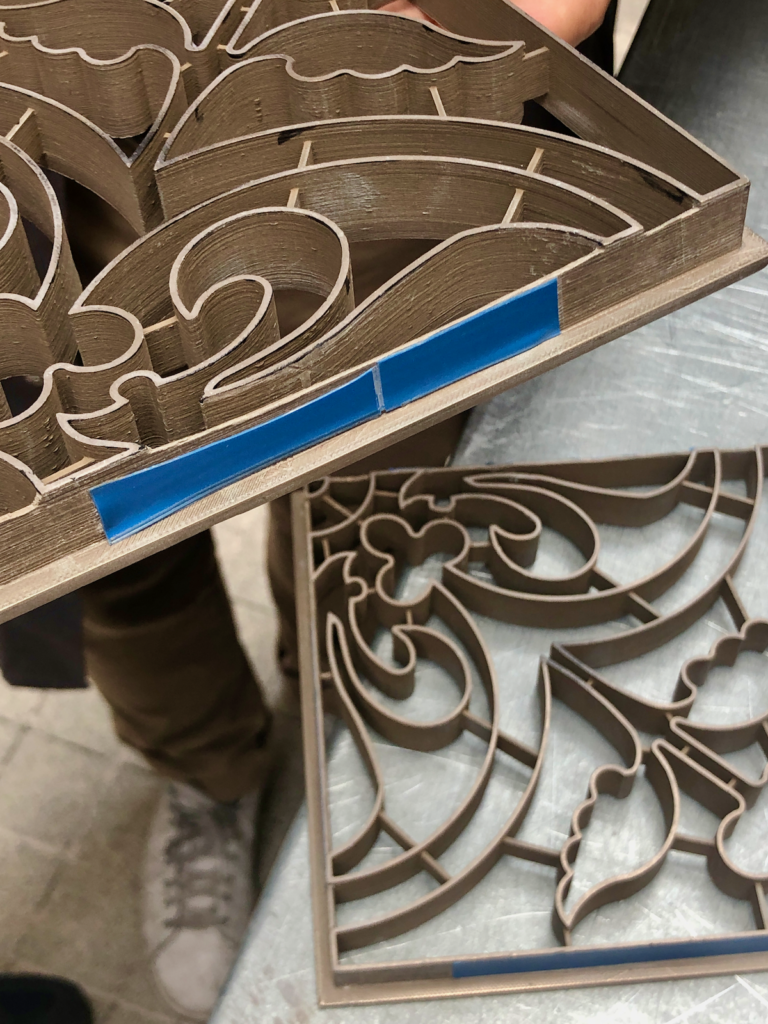
So if you’ve always wanted a tile with your logo, or your family initial or crest, they can create a tile mold just for you:

Next, the blocks of sand are compressed much further into the tile molds, and what comes out is unbaked tile. (Fun fact: certain machines are dedicated to red colors so the red residue doesn’t tint other colors. Just like with laundry.)
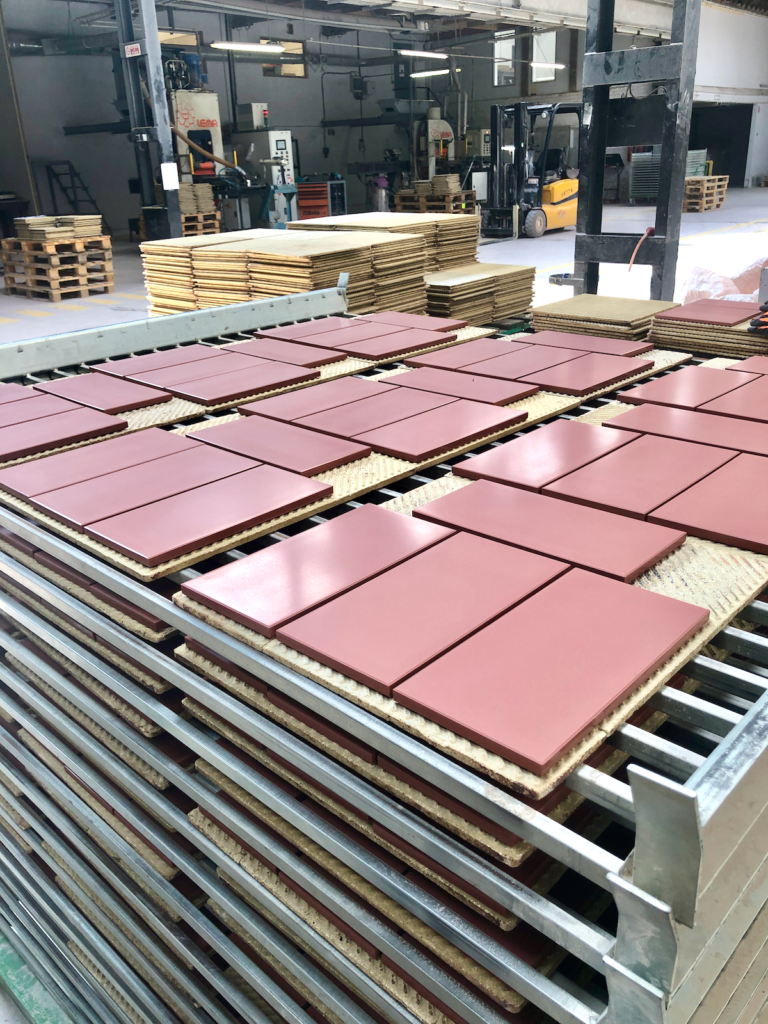

At this stage you could break the tile with your hands, and the tiles still have moisture in them, so they have a little bit of a sheen.
If there are any flawed tiles at this point, they can be returned to sand and reused. So there is no waste.
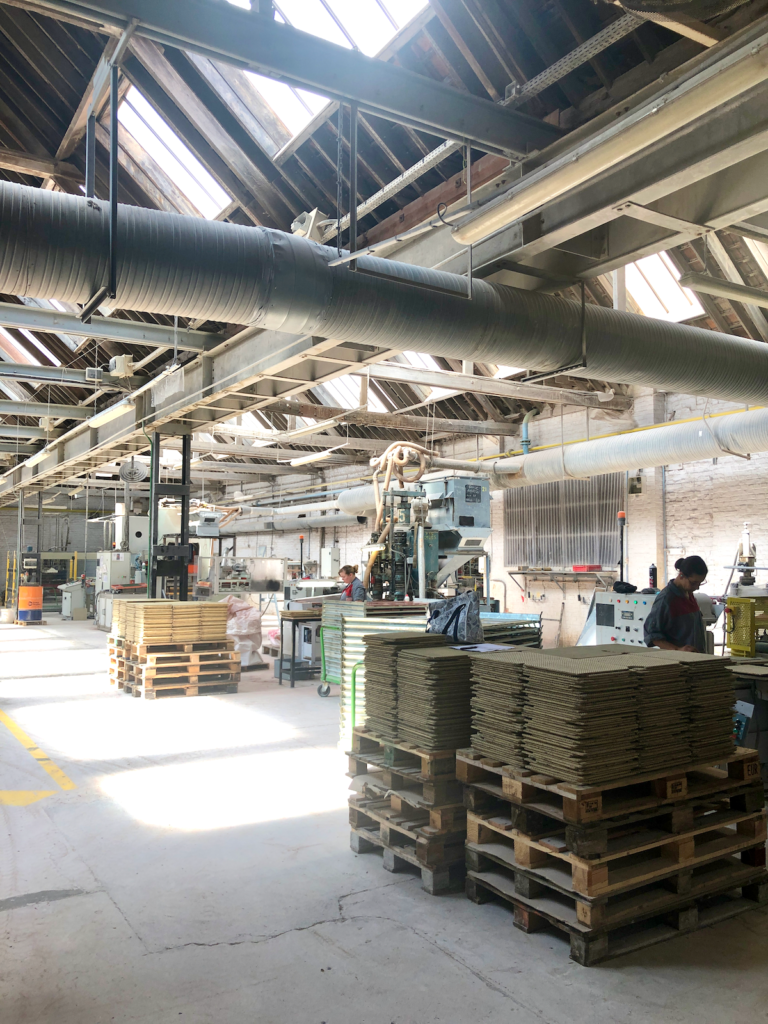
From here, the tiles go through a two hour baking process. It’s a long ride on a conveyor belt through that green machine that extends the whole length of the factory.
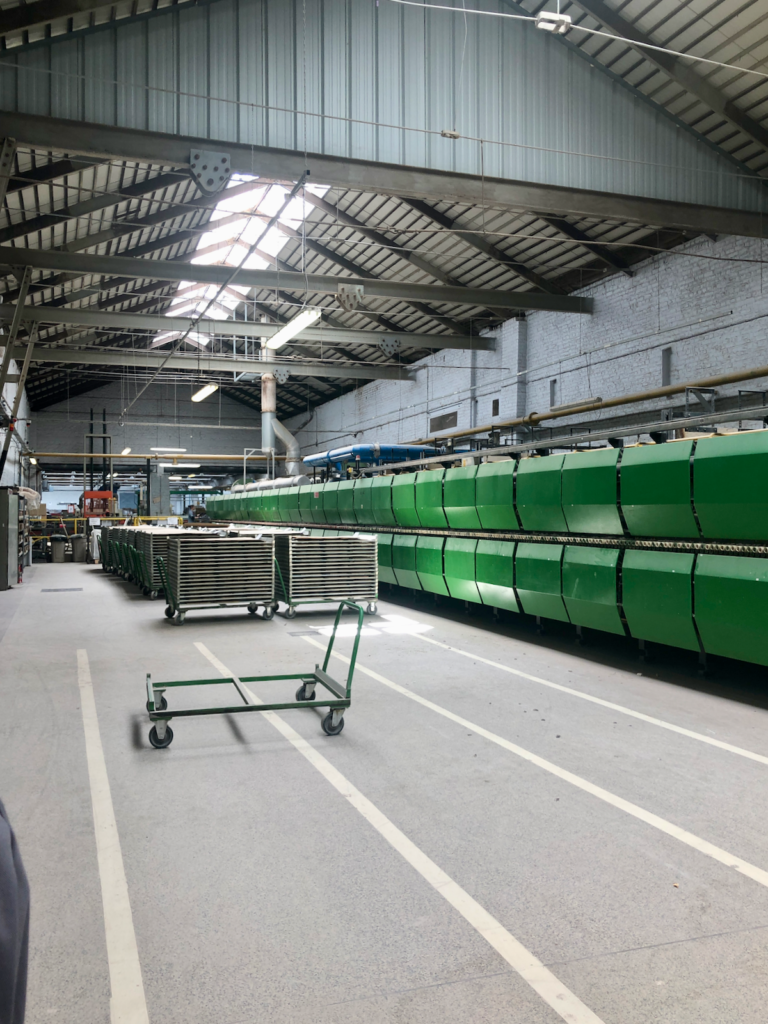
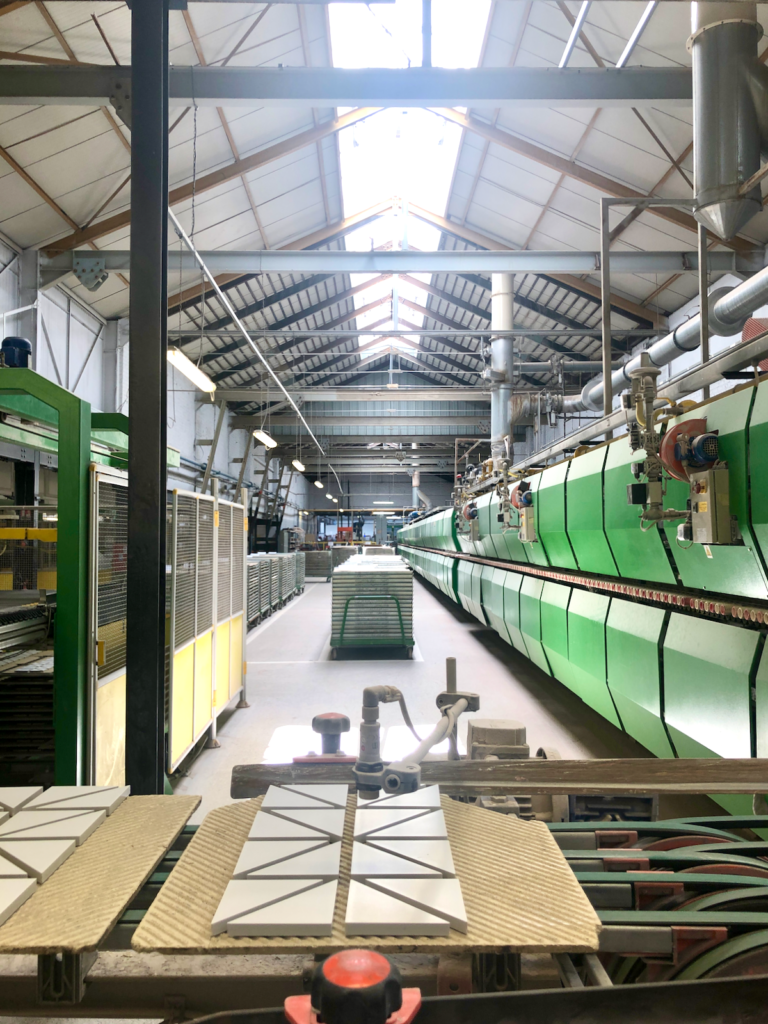
They become so hard during the baking process they are known as one of the hardest materials on earth. And all the moisture and sheen disappear so they are completely flat and matte.

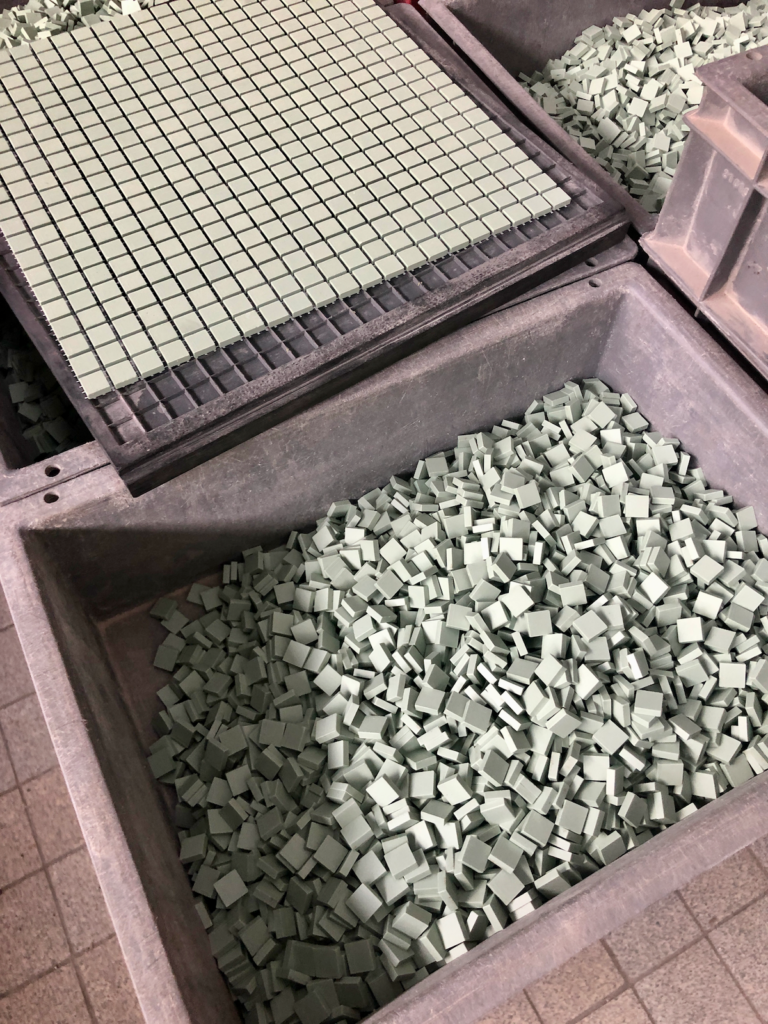
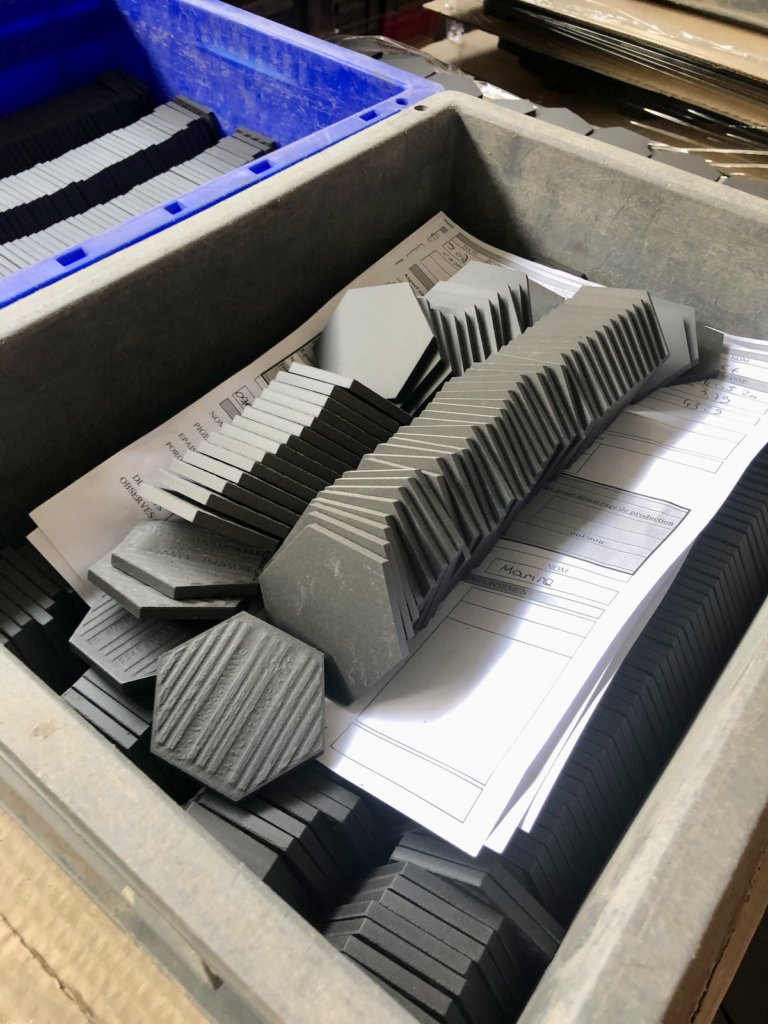
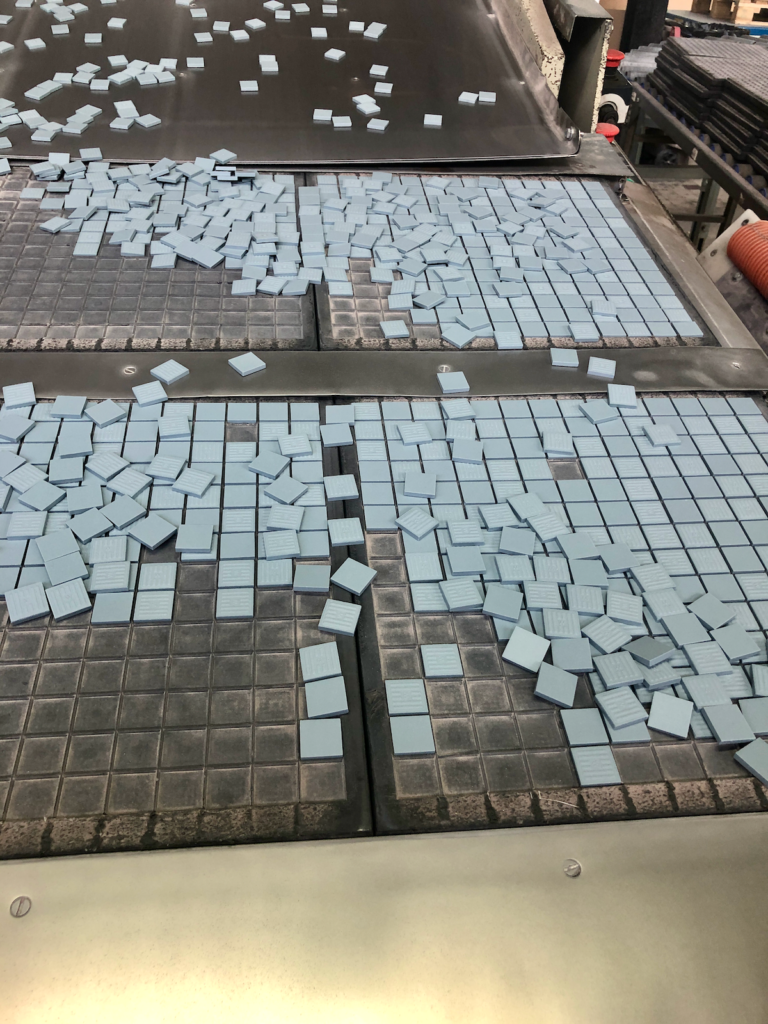
Next, the tiles might be stacked and boxed if they are one of the larger sizes. But if there’s a pattern of tiny tiles for a wall or floor area, they’ll be put on a mesh backing. (That way, the tile installer doesn’t have to install tiny individual tiles, instead they can install mesh sheets of tile that are about 12″ x 12″.
There’s a ton of skilled handwork involved in making the mesh sheets and it’s incredibly impressive to watch.
Winckelmans recently update their logo and packaging. Here’s the handsome new black and white box with the new logo:
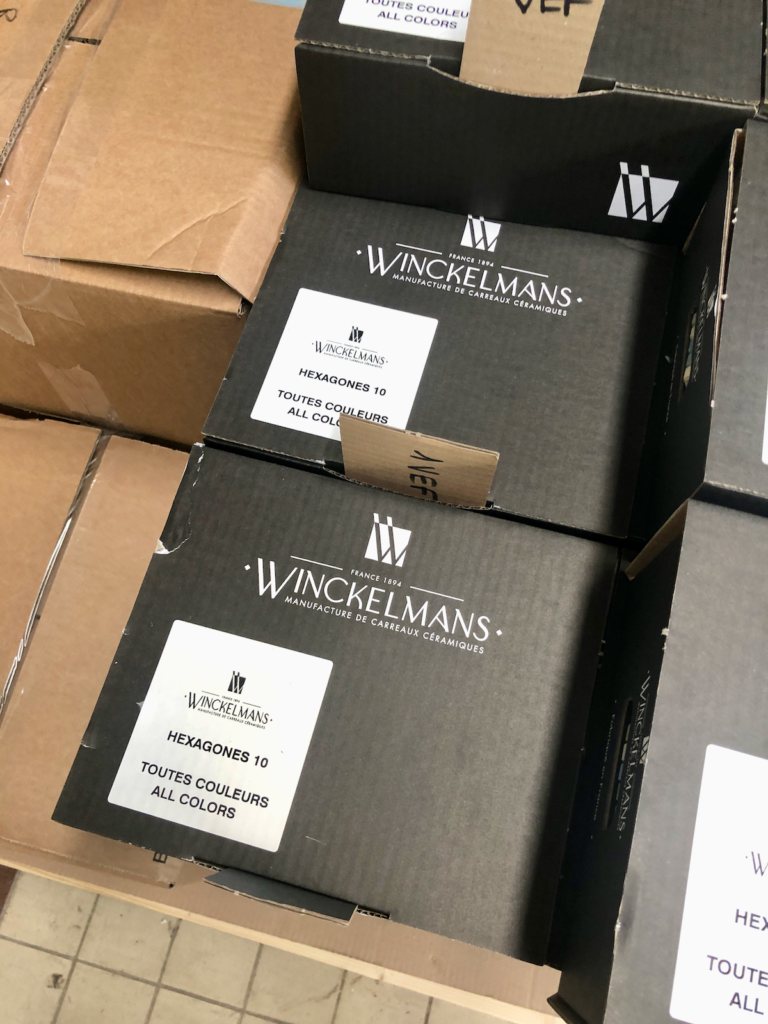
Something fun: At this point in the tour we got to see some of our tiles!! This is the design I came up with, featuring small hexagons in 4 colors. It was amazing to see it coming to life.
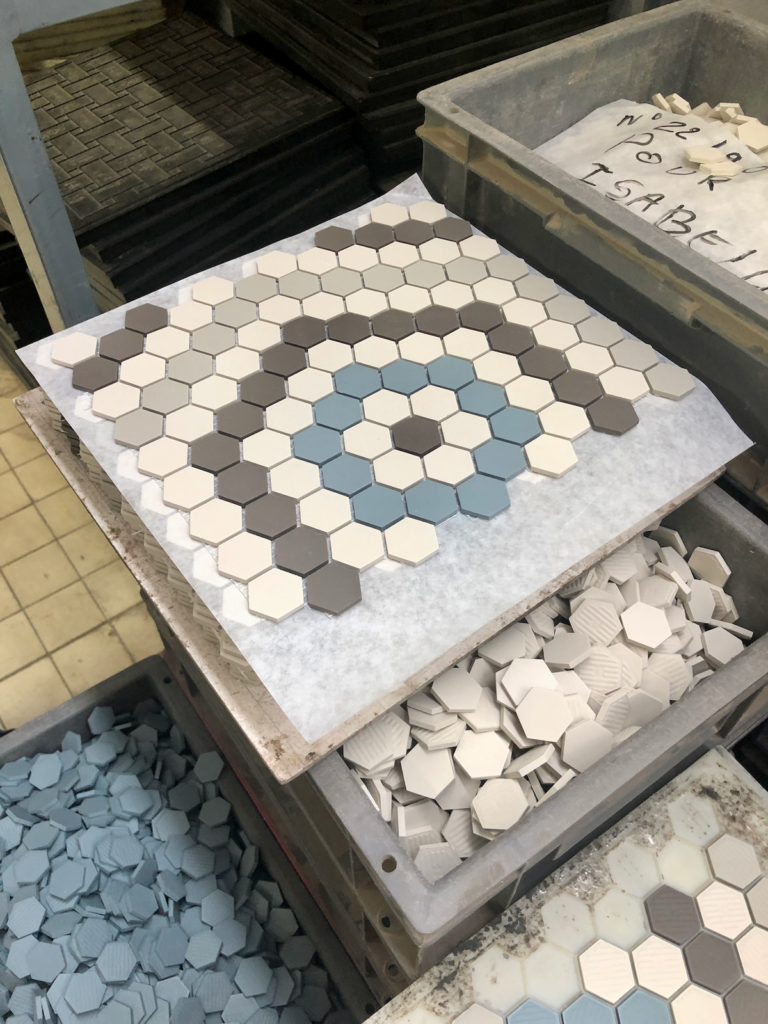

And those hexagon patterns? Those are all assembled by hand!!
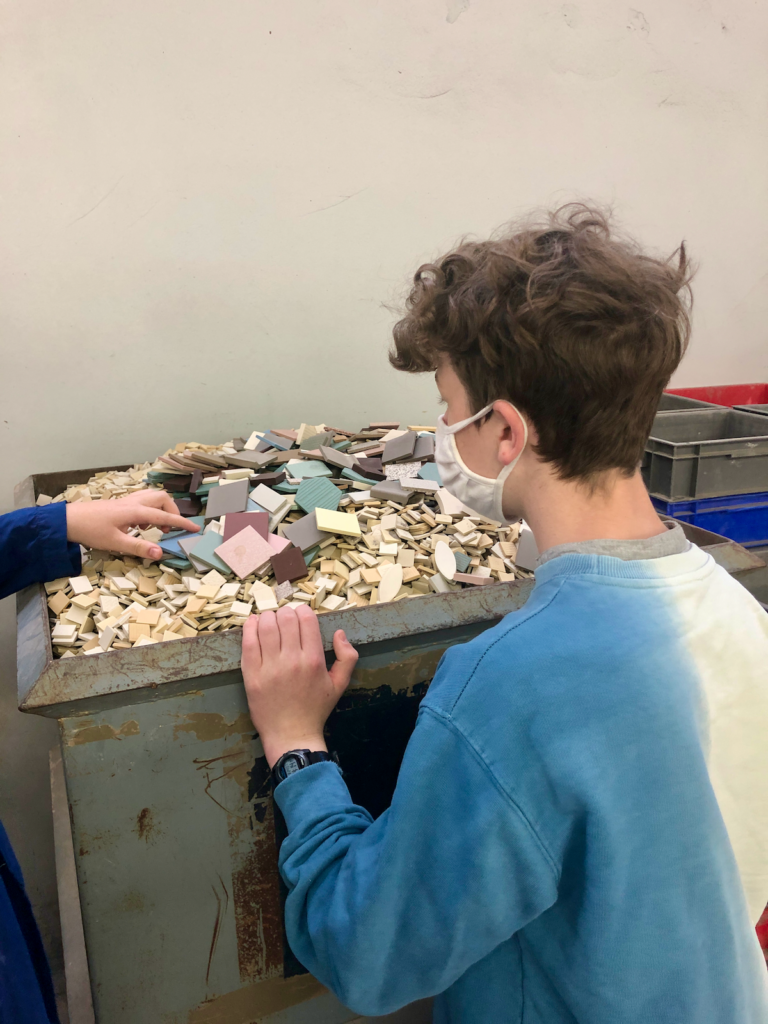
Throughout the process there are quality checks at every point. This bin is full of baked, discarded tiles that have tiny flaws. Mostly I could not spot the flaws — the flaws are so tiny you would need a trained eye to spot them.
All of these baked tiles are broken into smaller pieces and reused in a terrazzo-style flooring that Winckelmans offers — so again, nothing goes to waste.
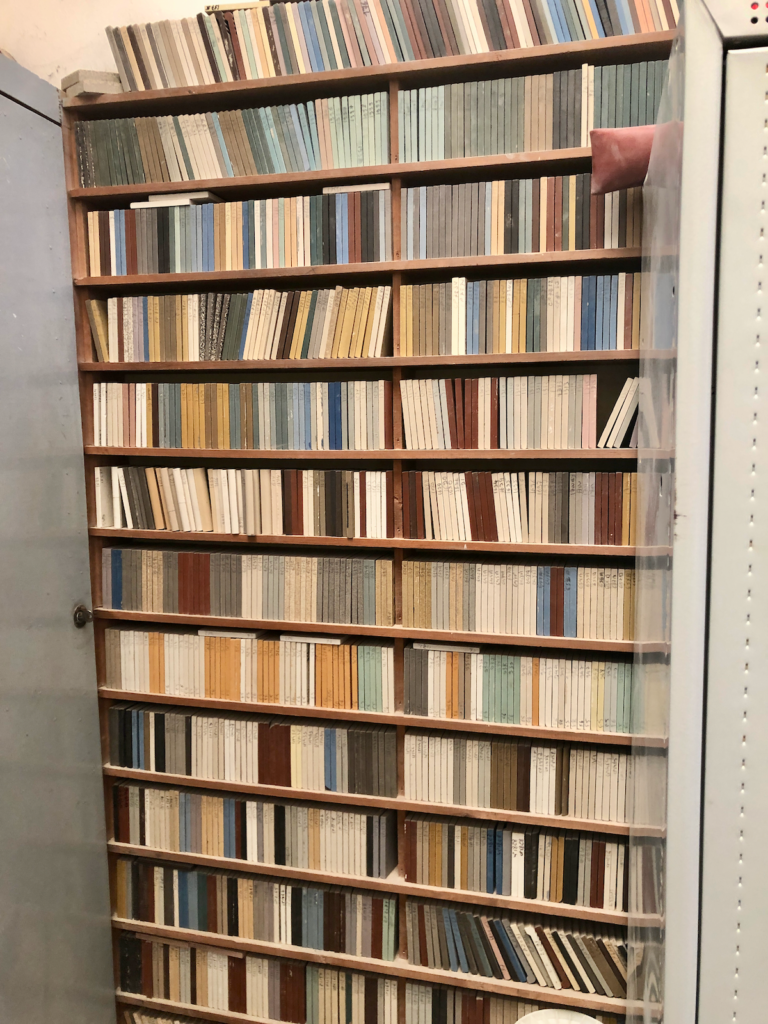
The science behind all of it is incredible. All of the raw materials shrink at different rates when they are baked. Both the materials and the degree of heat can create different shrinking effects. But all the finished tiles need to be the same size and shape, so each tile “recipe” needs to take into account the raw materials, the size of the original mold, and the amount of heat. A finished red tile and finished blue tile will look the same size and thickness, but the recipe for each will require different heat, different molds, etc. in order to achieve that identical finished size.
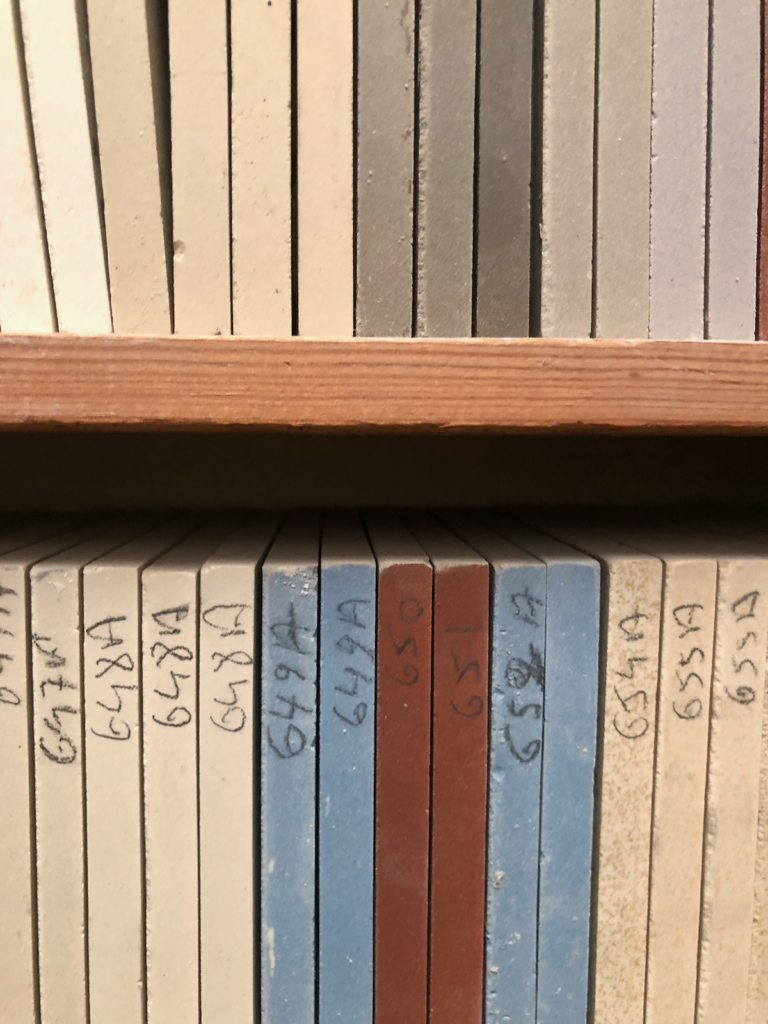
Winckelmans has been doing this for so long and has the science so perfected now, that the tiles are correct and perfect 99.5% of the time. There are so few that need to be discarded they don’t actually have enough for their terrazzo flooring and sometimes have to break up perfectly good tiles if they need more tile bits. Hah!
If you want to order samples for color, this is where that happens:
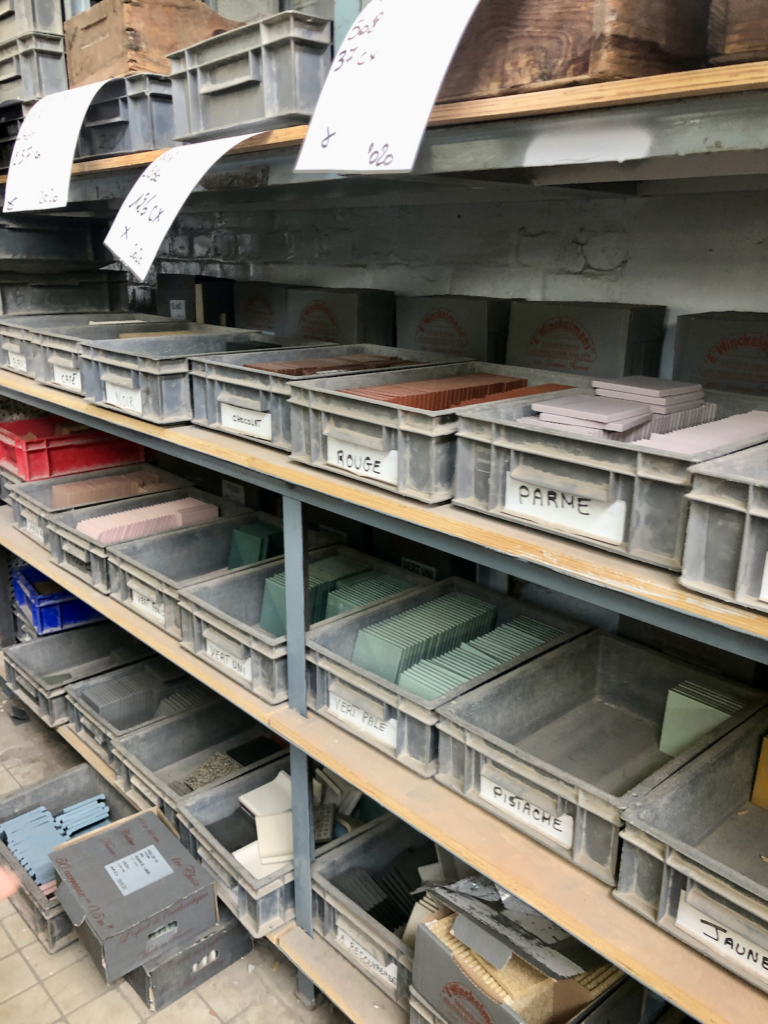
These shelves have all the Winckemans color options, and they’ll fill a box with your sample requests and send it out.
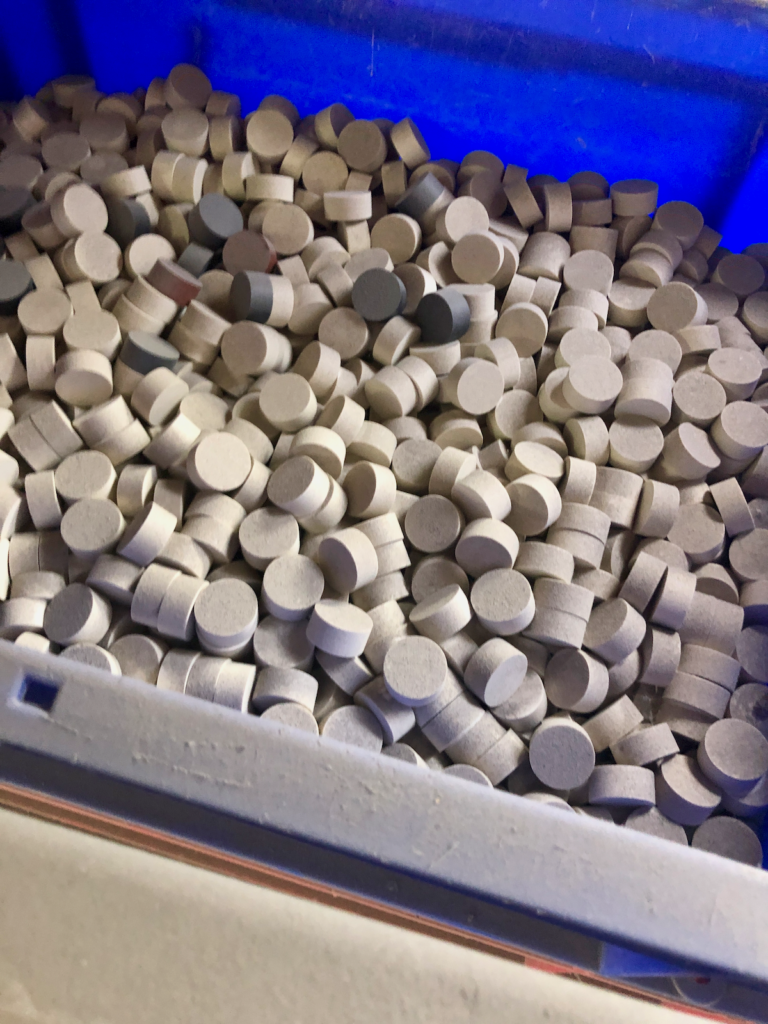
Though it’s a French company, they do a ton of work in English speaking countries — especially Australia and the U.S.. (One of their specialties is Victorian tile restoration.) So don’t be intimidated to reach out if you’d like to work with them.
They actually have several partners throughout the U.S. who can take you through the design process and help you place your order. There are so many options, it can feel overwhelming, and it’s really helpful to have someone take you through the process.
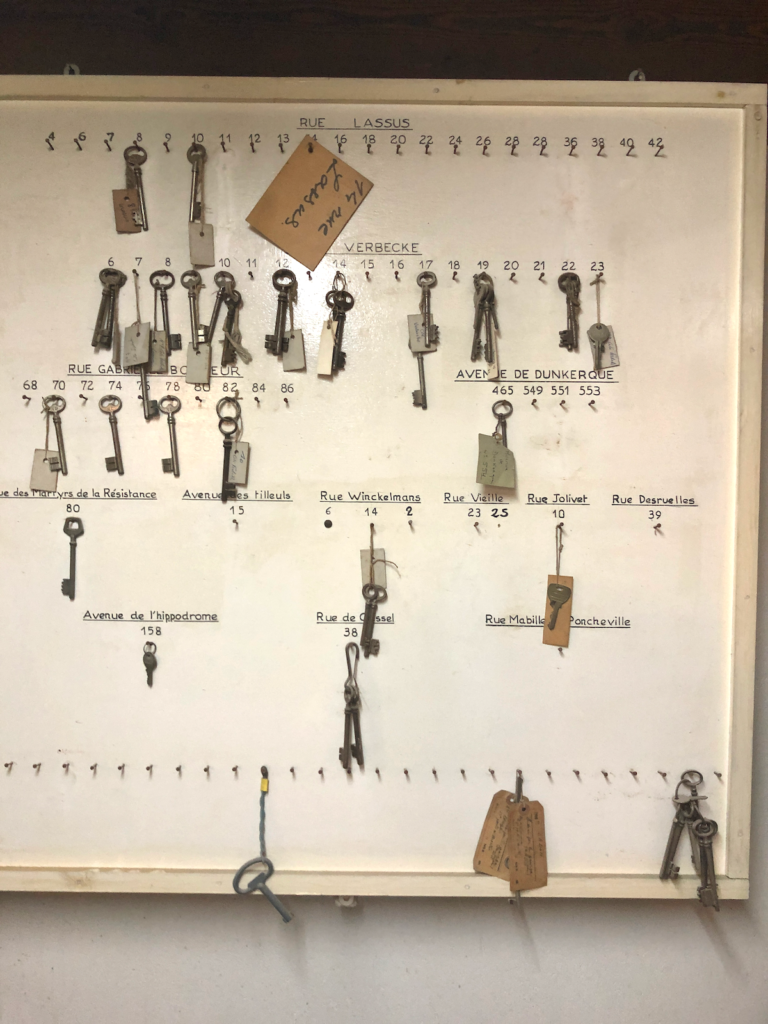
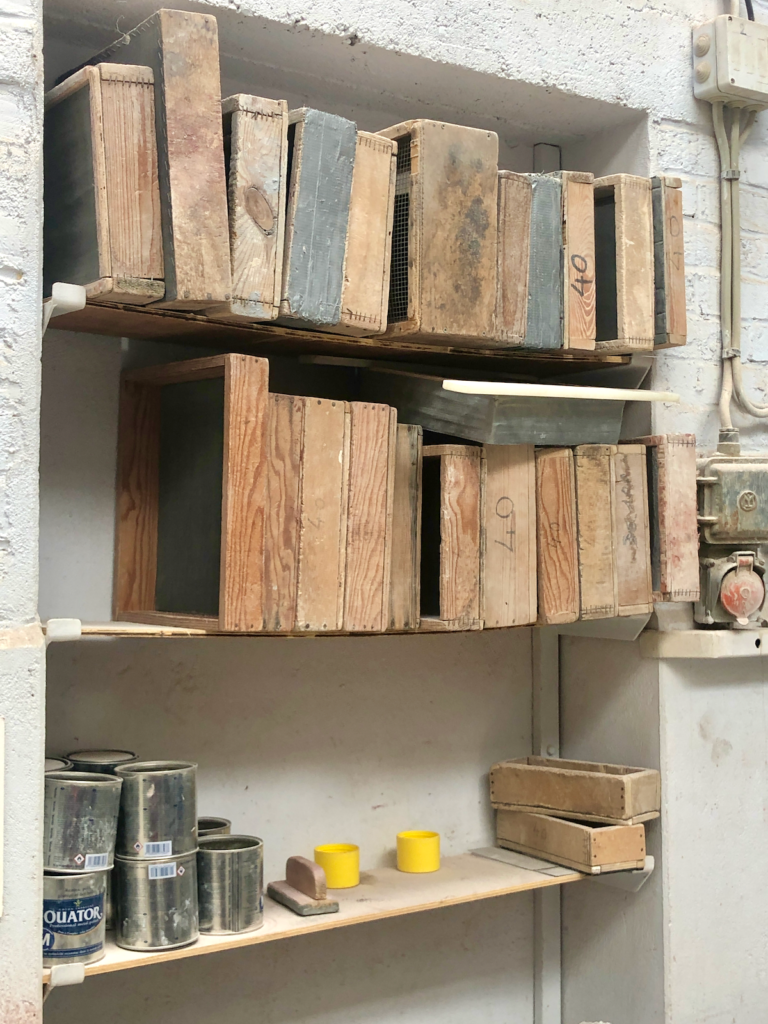
Take a look at the Winckelmans catalog to get a sense of what you can dream up— the potential combination of circles, triangles, squares, rectangles, hexagons, and octagons, make for endless design options, both modern and traditional.
If you want to start designing and aren’t sure where to start, I recommend finding a tile photo you like from the catalog, and then adapt or expand the design from there. And the Winckelmans design partners will take you through all the options for specialty tile pieces (like for corners or edges) if your design needs them.
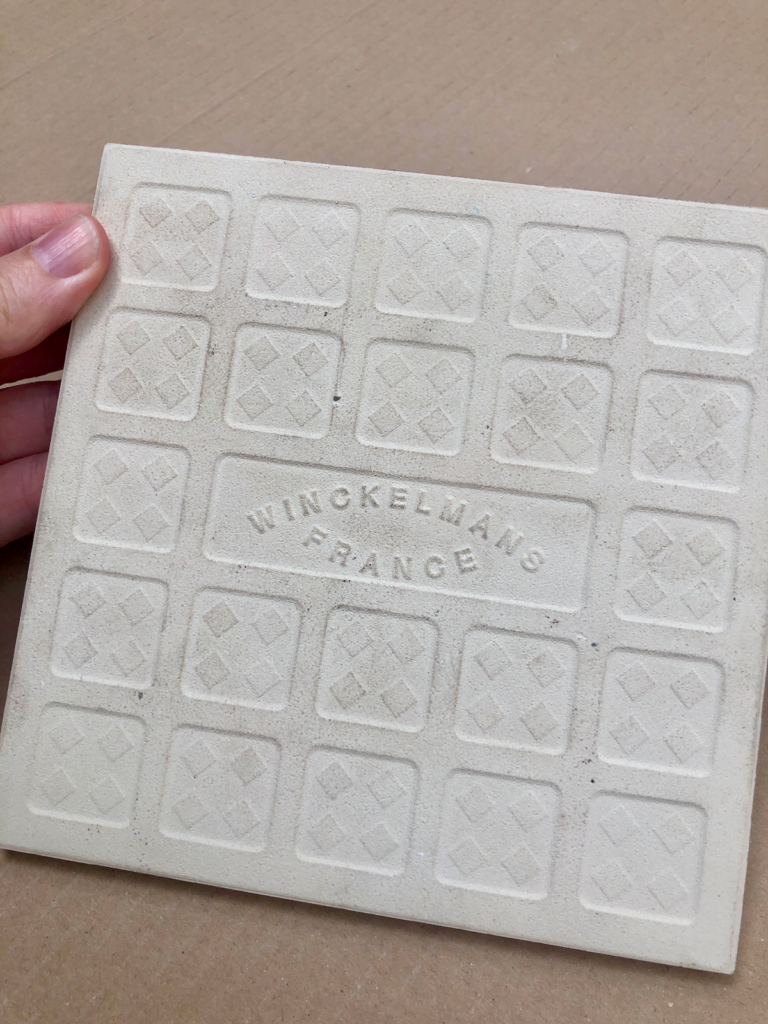
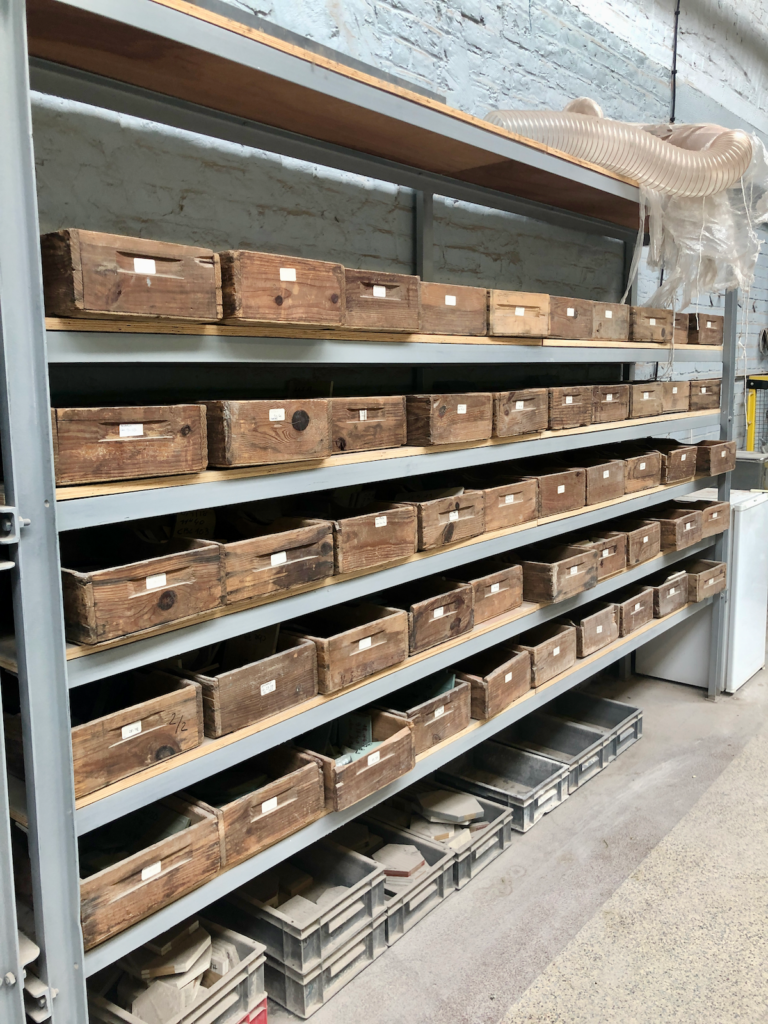
Of course it’s fun to go to a showroom and see the tiles in person, but if you can’t get to a show room, you can still totally order online. That’s what we did. I came up with our design and placed the order before I’d ever seen the tiles in person.
Prices for standard brick tiles seem pretty competitive to me (based on other tile research we’ve done) and could be ready to ship quite quickly — many of the most in-demand sizes and colors are “in stock”.
But for a custom order, like our hexagons for the bathroom floors, plan on more time — 6 to 8 weeks (or more) depending on the complexity. But that shouldn’t shock you when you realize they are literally starting with bags of sand and then delivering exactly what you dreamed up, ready to install on mesh sheets. It’s remarkable.
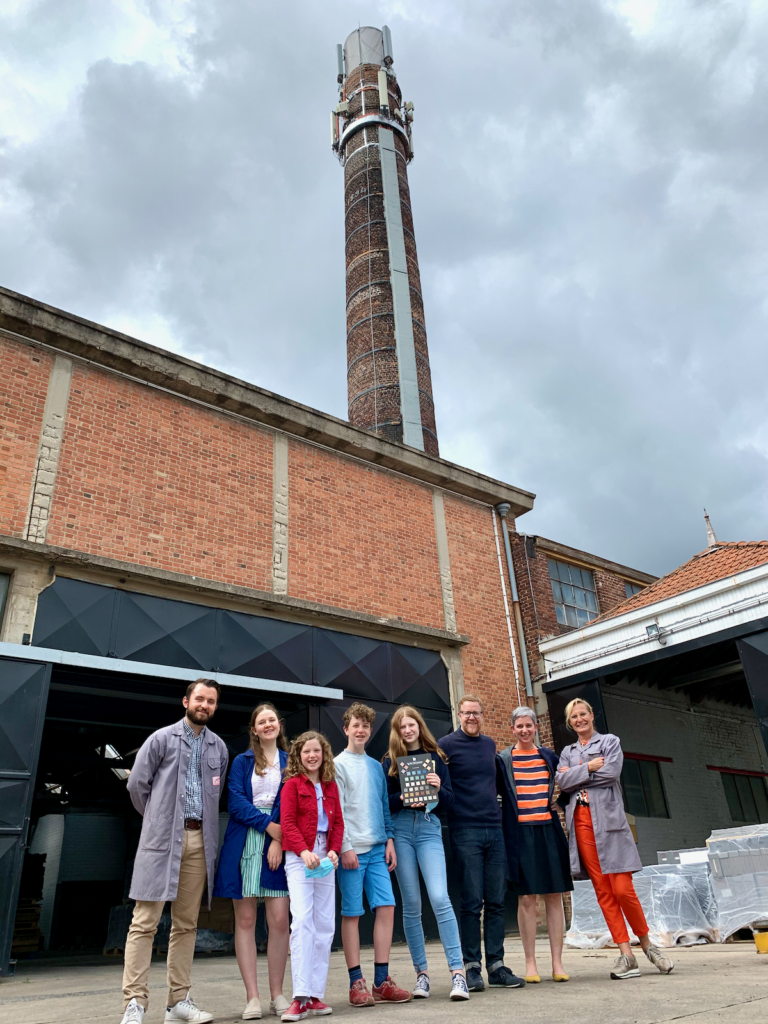
So that’s the end of the tour. But! Right next to Winckelmans, was another small factory (also 5th generation!) that produces faucets (called Herbeau), and we got to tour it too. So I’ll tell you about that later.
I’m so glad we got to make this visit. I had been searching for months for tile that was produced in France and felt really French — tile that would fit right in on the floor of a Paris café. A couple of French Instagram followers recommended Winckelmans and I’m so glad they did. As soon as I got to their website it was like: That’s it! That’s the tile I see all over France!
Your turn. Do you enjoy factory tours? Have you ever taken one that stands out in your memory? Does a custom tile project appeal to you? Or do the options feel overwhelming? Are there any old buildings in your town that have tiny matte tiles? (I’m betting they were made in Lille at the Winckelmans factory!)
P.S. — Do you remember watching the factory tours that were sometimes featured on Mr. Rogers? They were always my favorite. I LOVE factory tours.
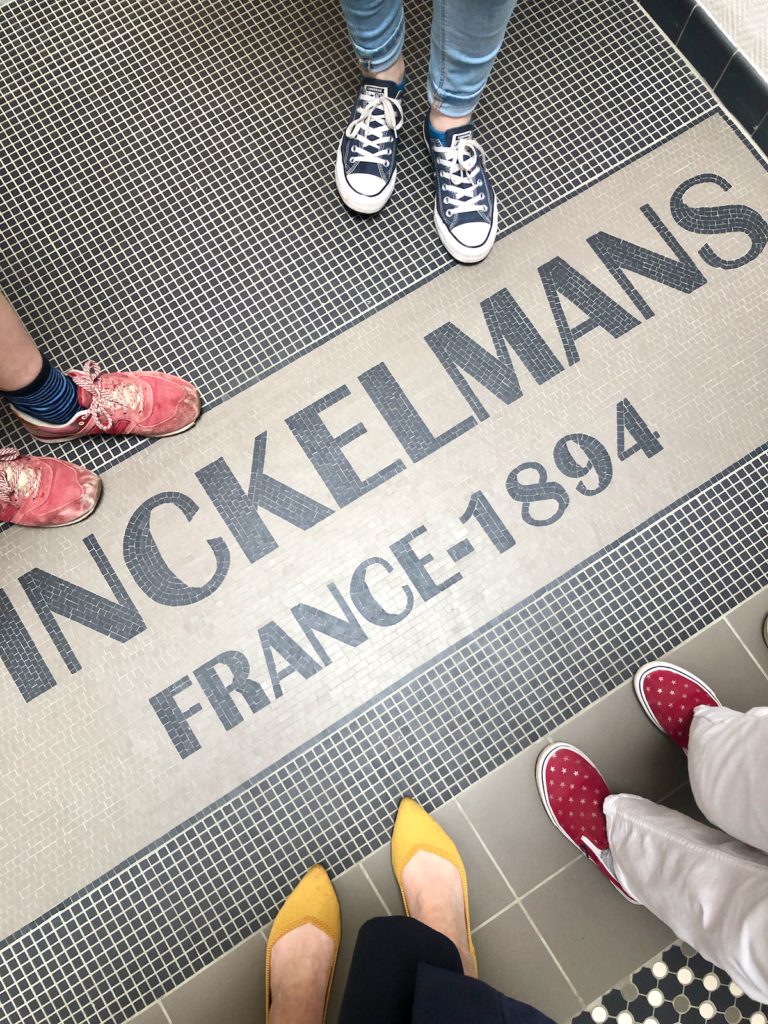
Thank you so much for this detailed article! I hope I can order their tiles for my house one day too !
Thanks for reading, Miranda.
LOVE this!
Same! I love a good factory tour.
Took a tour of the Volvo factory in Sweden. Loved the history, the process and their museum of safety inventions through out their history that they share with all car manufactures so everyone can be safer on the road. And loved their Swedish meatballs in their cafeteria.
The Volvo Factory! Ben Blair and I took that tour as well. And we both loved it. So good!
Thank for for sharing! So fascinating! I love factory tours. Can’t wait to see your final bathroom.
I am SO EXCITED! It looks like the tiles will be installed in August, and the fixtures after that, so it’s possible we’ll have working bathrooms in September.
I’m itching to style and photograph these spaces, and I can’t wait to see what the tile actually looks like in the rooms.
I was 100% picturing the crayon factory tour from Mr. Rogers as I browsed through your pictures! This is so great!
I was thinking the same thing! So soothing and satisfying to see those crayons made on Mr. Rogers!! Also, I love this tile. Beautiful!!
Right? As I was putting together this post and the Instagram stories (which include video segments), I was totally feeling the Mr. Rogers vibe, and I remembered how much I loved those segments. They clearly influenced me.
I laughed when I read your P.S. since I literally had a flashback to Mr. Rodgers and his tours as I was looking through your tour. Fun memory! Thank you for that and this neat post. Loved it! Can’t wait to see your tiles.
Thank you for this tour! I absolutely love factory tours and take them whenever I can. I studied Operations Production Management (now called Supply Chain) in University! I have so many favourites but here are a few – Rock of Ages Quarry in Vermont, any automotive plant, Caves Bouvet Ladubay in Saumur France.
What a cool thing to study!
Off to google Caves Bouvet Ladubay…
Fascinating! When I was in elementary school, our class took a field trip to a Hostess factory in Cleveland. At the end we got a goodie box! Unfortunately the next year the field trips ended as some child dropped a bobby pin in one of the vats of batter. But also agree on car factory tours – I’ve done BMW (in SC) and Ford (in one of their factories in Germany).
Oh my goodness! The little details in your comment are so good. I’m sure it felt like such an adventure to visit the Hostess factory. Twinkies being made before your eyes? What could be cooler. And too funny that a bobby pin was dropped in the works!
This tour just made my day. I’m having the covid blahs, and am trying to cut back on my doomsday scrolling. Looking through these photos, reading about the tour-it was just the pick me up I needed. (Actually all of your stories of your house renovation, and all the touring in France is really helping me-thank you.)
I hear you on doomsday scrolling. Ugh.
And thanks for the feedback. Since the pandemic began, I’ve found it’s really hard for me to concentrate long enough to write a post like this, but I found this one quite soothing.
I would have never thought of taking a tour of a factory but now that I’ve seen one it makes sense! That was fascinating, thank you so much. I love those tiles, I have a big collection of photos; there are so many, in the south of france, in Marseille for example. They’re so beautiful. Your bathroom will be splendid.
At first, I just wanted to see the showroom and check out the colors and sizes in person, but when they suggested a factory tour, I was like YES. I always love a good factory tour. It’s like watching the creative process happen before your eyes.
Thank you so much for sharing this and all the wonderful pictures. It was fascinating.
Thanks for reading, Colleen.
Last summer we visited a foundry – which was super hot in July, but neat to see craftsmanship in person.
I don’t think I’ve ever visited a foundry. Sounds very cool.
Thank you thank you for the info!!! I loved going on the tour “with” you. We are currently building our first home and I am going to reach out to them immediately. Thank you so much for sharing this resource! It is exactly what I have been looking for and would never have known about them if not for you!
Yay! Have so much fun planning out your tile design! I very much appreciated when readers encouraged me to check out Winckelmans, and I’m so glad I could share what I learned.
This was so incredibly fun! All the delightful details and the historical tidbits… truly an escape from the depressing reality of my day today. Thank you!!
It really was a treat just looking around the buildings. There were so little details packed with history. It was a feast for my brain.
Ditto some of the above folks – I LOVED the crayon factory tour on Mr. Roger’s Neighborhood as a kid! The Jolly Rancher factory also used to be in my hometown and my dad used to take us there after half-day kindergarten sometimes. I think he just wanted something for us to do, but we loved it so much!
Oh my! The Jolly Rancher factory? Sounds like the ideal kid factory visit.
Oh I love a good factory tour! The Kellogg’s Factory in MI was my favorite as a kid. My adult favorite is Heath Ceramics in Sausalito. Have you been Gabby? It’s wonderful and their wares are so so good!
I agree with Heidi up there – this lovely trip to France was exactly what I needed today. Thank you.
We are about to embark on a remodel (our first ever – I. AM. TERRIFIED.) and I see so many patterns that would be just right for our SF home. I have to say I really appreciate all the details you provide about your projects. The opportunity to see what you and Ben Blair have done helps me feel like my husband and I can definitely, maybe do this! (It’s a rule that one must say “Ben Blair” right? Just “Ben” sounds funny in my head.)
Can you believe it? All those visits to Sausalito and I never ended up going to Heath Ceramics studio (though I would frequent their shop at the Ferry Building).
And huge congrats on starting your remodel. It for sure gets overwhelming sometimes, I keep a notebook with me to make lists or right down ideas or assignments and it helps keep some of the chaos out of my brain. Good luck!
(Yes, totally say Ben Blair. It just sounds right.)
This post and your Instagram stories about this home restoration have been so fun and fascinating to me. You explain things in such a clear way. I love when you take us through your thought and decision making process. Thank you for sharing this with us. It has been my favorite thing in 2020.
I really appreciate you saying this, Mia. Thank you.
I enjoy seeing/hearing/reading the creative process happening and I’m glad to share my own creative process when I can.
This was such a wonderful salve at a time where the world is so fragile right now. They survived and thrived through many challenges. It gives me hope!
Right? So many massive changes to their industry, and then being bombed! And they just keep plugging away, doing what they’re good at, and making improvements as they go.
Amazing! I chose this tile for my bathrooms and laundry and laid them all myself. Hex black penny tile on the floors with a skirting board of the square blacks and I absolutely love that they will last forever. They’re a joy under foot, you’re going to love them!
LOVE hearing this Tracey. I’ve been thinking about what they’ll feel like under bare feet, and I”m delighted to hear they are a joy.
The penny hex tiles are so dang cute/awesome!
I loved the details of the tour and hearing of the company history.
I can’t believe you got to see your own tile. It’s going to be so beautiful!
That was such a fun surprise! I had no idea we would get to see our tile and I just about jumped for joy when we turned the corner and saw it.
Thank you so much for this. We are going to be using Winckelmans tiles for our renovation in Amsterdam (the Dutch connection :-) ), so it was fantastic to see where they come from and hear how they are made. In fact, I think I saw one set of our tiles in the pictures. Awesome!
Hi Gabrielle, thank you for this great post !
If you’re into factory tours, I strongly recommend https://www.entrepriseetdecouverte.fr ! They do a great job listing all companies in France that welcome visitors :)
Oof, I’m so sorry to report that what was probably Winkelmans’ tiles in our Bronx bathroom, got covered with self-leveling compound and Home Depot tiles 15 years ago. Sob! I wish I’d known better at the time.
As for factory tours, many years ago my husband, daughter, and I went on the Cabot factory tour in Vermont. We hadn’t had lunch before the tour so we DESCENDED on the cheese samples at the end – we were starving! It’s both funny and embarrassing to remember. :)
We did so many tours on that trip in addition to Cabot – maple syrup, chocolate, Ben & Jerry’s. So fun!
Looks like you all had fun at the factory! It is a lovely COVID distraction. I once got to tour a Garoto Chocolate in Brazil (which included all the chocolate you could eat). It’s always so interesting to better understand what goes in to making a product – and increases your appreciation of it.
On an unrelated note, but in the scope of great COVID distractions, I’m hoping you will do a back to school fashion post again this year. It would be great to see how France compares to the US.
So fun to live vicariously through your post! Our most notable factory tour was probably the Pendleton tour in Washougal, WA. It was small enough to be personable but so thorough in taking us from start (shorn wool) to beautiful blankets. There is something special about seeing a heritage product at its origin.
Your Insta stories of beautiful places in France have been such a lovely source of calm for me lately. And this factory is dreamy–those wooden boxes!
I have to tell you that the ads I got along side this article were for floral toilets and bidets. It made me smile. They definitely got the memo about fancy ceramics. I’m just imagining, though, a floral bidet in your new master bathroom and GRINNING. ;) xox
Thank you for the field trip! Fascinating and lovely. I love how their tile seems all matte colors. Is this true? Do they fire with shiny glazes too? We have Pewabic here in Detroit. Much smaller scale factory but just as wonderful! Can’t wait for the next tour!! Thank you!!!
We love the Fragonard Perfume tour in Grasse , near Nice, France
We still get perfume samples delivered with their catalog quarterly!
This is fascinating! Thank you for sharing all the details, including the history and improvements made for the workers. I loved it. And, yes, always a fan of factory tours! Thanks again.